Wrapped in rich shadowy tones, today’s living rooms are throwing off their fear of the dark and embracing a moodier palette that feels both luxurious and comforting. Designers note that deep hues soften architectural lines, showcase texture, and make light sources sparkle—turning an ordinary lounge into an intimate retreat. Pinterest Allisa Jacobs Home & Design
1. Charcoal Walls Cocoon Your Living Room
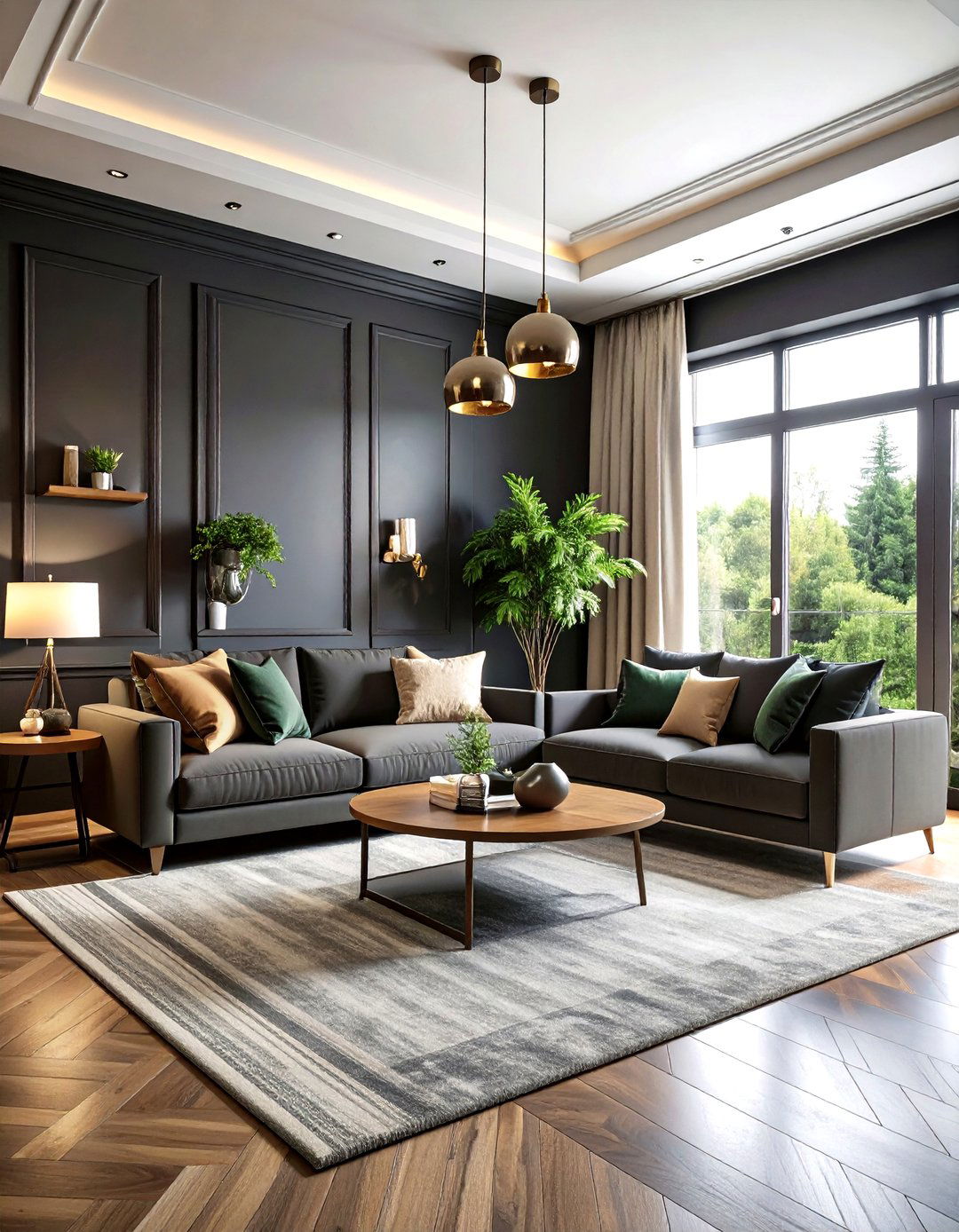
A saturated charcoal envelope instantly shrinks visual boundaries, making the living room feel like a snug hideaway rather than an echoing hall. Color-forecast reports highlight inky blacks and graphite greys as go-to shades because they absorb glare and let furnishings shine. Allisa Jacobs Home & Design Keep ceilings matte to avoid harsh reflections, then choose a slightly lighter tone for built-ins or trim to maintain depth without flatness. For renters, large-scale peel-and-stick panels in dark grey create the same dramatic shell and peel away cleanly when it’s time to move. Finish the look with dimmable sconces so the walls appear velvety at night.
2. Layer Soft Lighting in the Living Room
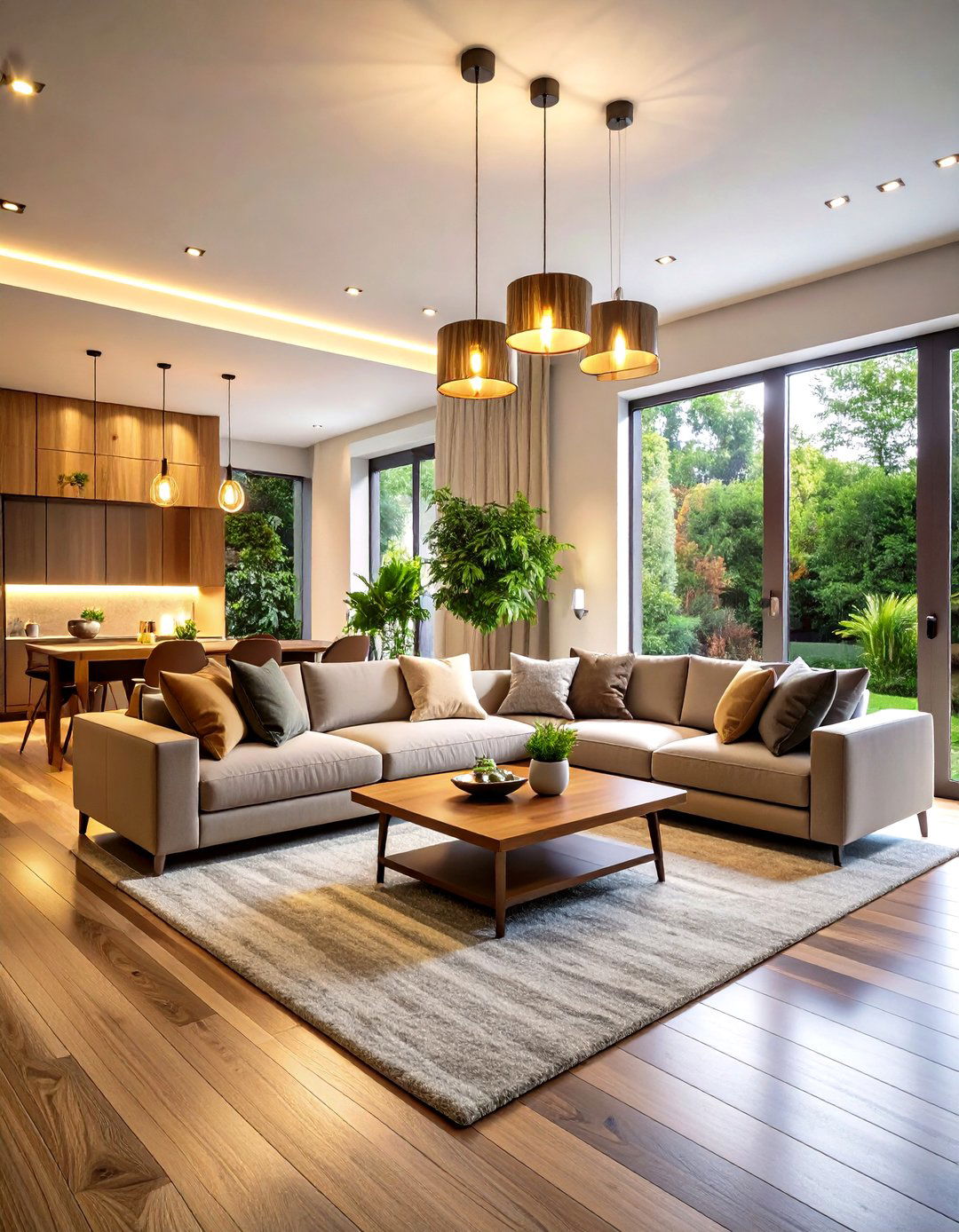
A single overhead fixture leaves dark rooms feeling cavernous; a trio of ambient, task, and accent lights turns them inviting. Lighting specialists recommend balancing recessed cans with floor lamps and picture lights to bounce gentle pools of brightness around the room. Decorilla Position warm LED bulbs (2700–3000 K) behind seating to prevent harsh shadows on faces. Add a spotlight over artwork and a low-glare strip under shelves to create visual rhythm. By staggering heights—table lamps at eye level, pendants above sightlines—you avoid hot spots and keep every corner comfortably aglow.
3. Warm Metallic Accents Lift a Dark Living Room

Brass, copper, and bronze glint beautifully against moody paint, acting like built-in candlelight. Current décor trends single out hammered trays, slim-legged side tables, and sculptural sconces for the gentle shimmer they add without overwhelming the palette. Lushome Even small touches—drawer pulls or picture frames—catch stray rays and reflect them into surrounding shadows. Aim for two or three repeating finishes so the space reads cohesive; a vintage brass lamp marries nicely with modern copper planters. Finish metal pieces with a brushed or aged patina to prevent an overly showy shine and keep the room grounded.
4. Plush Textures Add Living Room Comfort
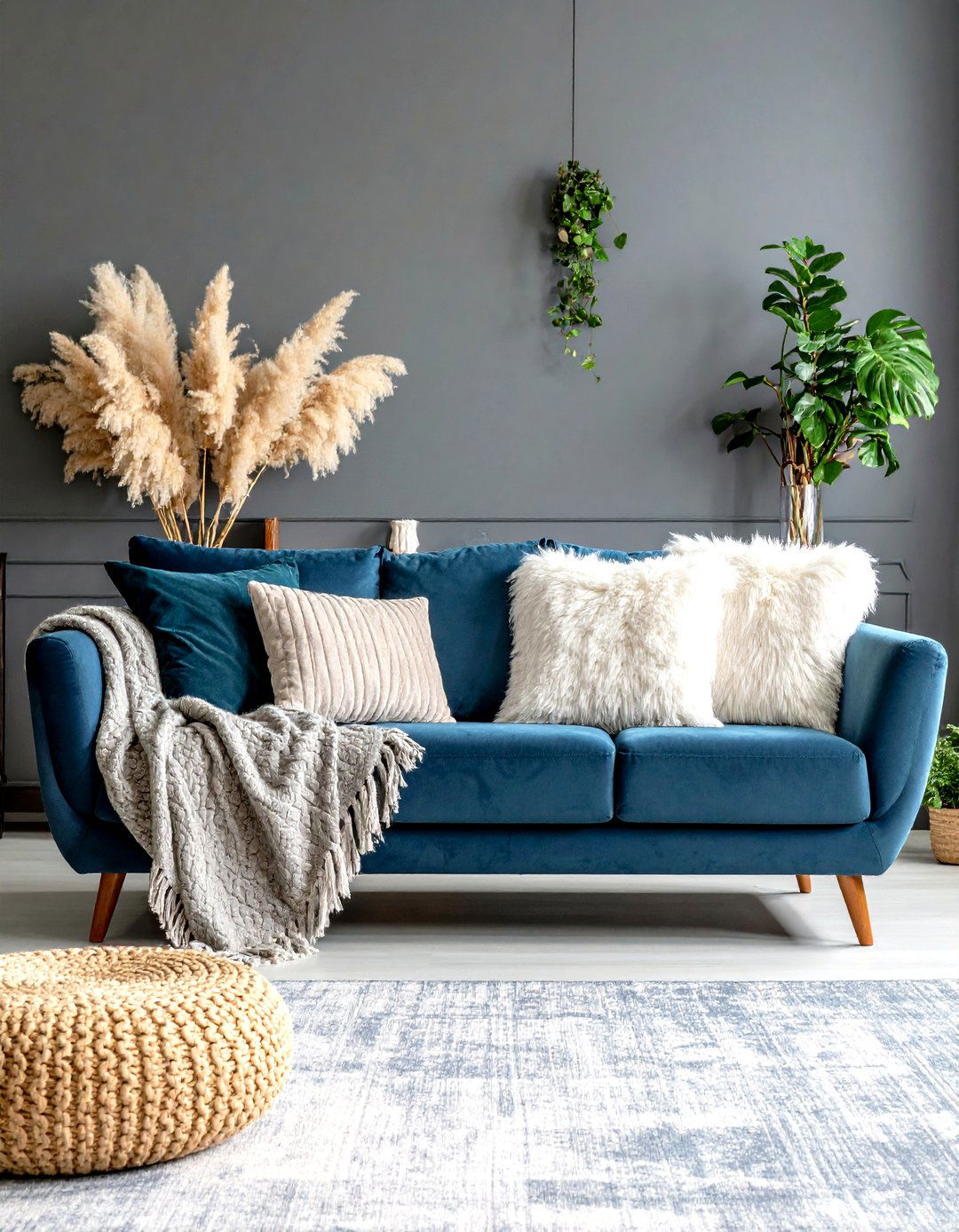
Dark rooms rely on touchable layers to avoid feeling chilly; plush velvet, bouclé, and chenille invite hands and eyes alike. Inspiration galleries showcase midnight-blue or forest-green velvet sofas that soak up light yet glow softly at twilight. Pinterest Drape a chunky knit throw over the arm and drop in a faux-fur cushion for tactile contrast. When mixing fabrics, vary pile height—pairing low-nap velvet with nubby wool prevents a monotone look. Don’t forget the floor: a deep-pile area rug underfoot instantly doubles the coziness quotient when walls and seating lean dark.
5. Natural Wood Warms a Dark Living Room
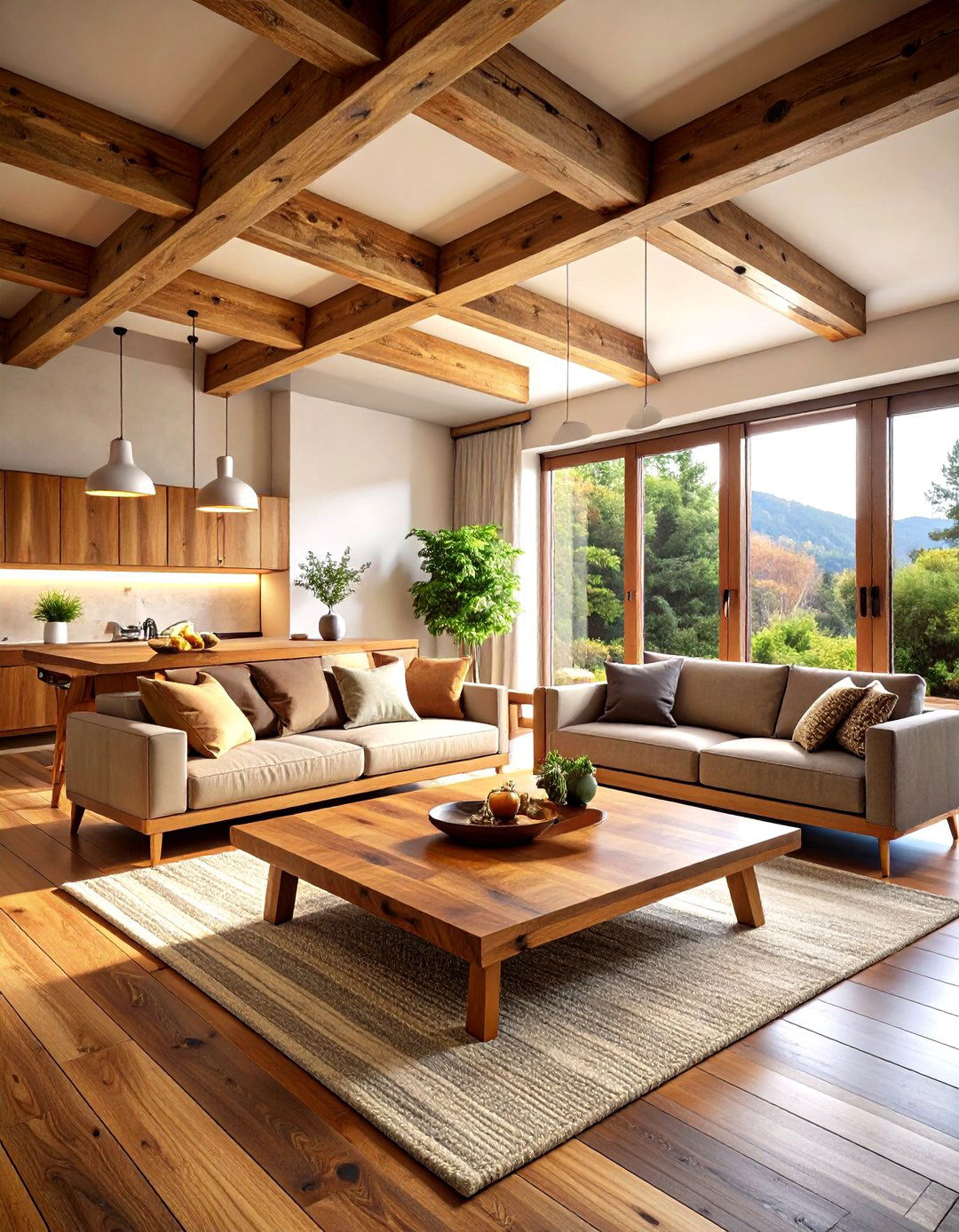
Raw oak coffee tables, walnut sideboards, and exposed beams break up expanses of dark paint with organic warmth. Designers praise the pairing because the wood’s golden undertone counters cool charcoals and navies, making the scheme feel balanced. Pinterest Opt for a matte finish so grain patterns remain the star, or white-oil lighter woods for a Scandinavian twist. Wooden picture ledges also let you swap art seasonally without hammering holes into richly painted drywall. Keeping wood tones consistent—two variations at most—prevents the palette from splintering into visual clutter.
6. Dramatic Artwork Anchors the Living Room
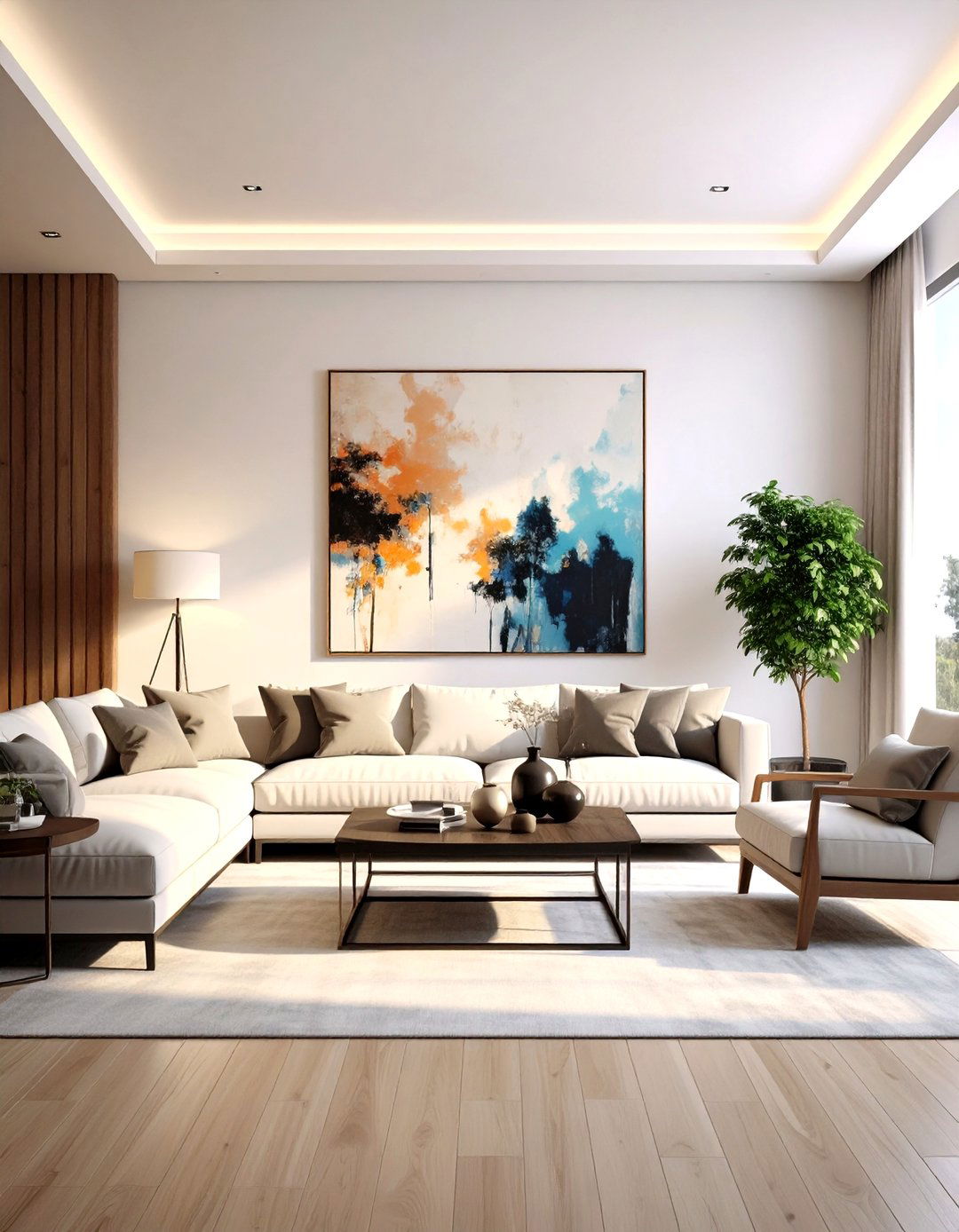
A bold canvas or oversized photograph becomes magnetic against a shadowy backdrop. Curated image boards reveal that muted surroundings intensify color saturation within the artwork, so even soft pastels pop. Pinterest Hang pieces at eye level and, if possible, wire a picture light above to draw a golden halo. For renters, peel-and-stick murals in sepia landscapes supply scale without frame costs. Maintain a generous border of wall around each piece—negative space lets the art breathe and underscores gallery-like impact.
7. Light Rugs Ground the Living Room Darkness
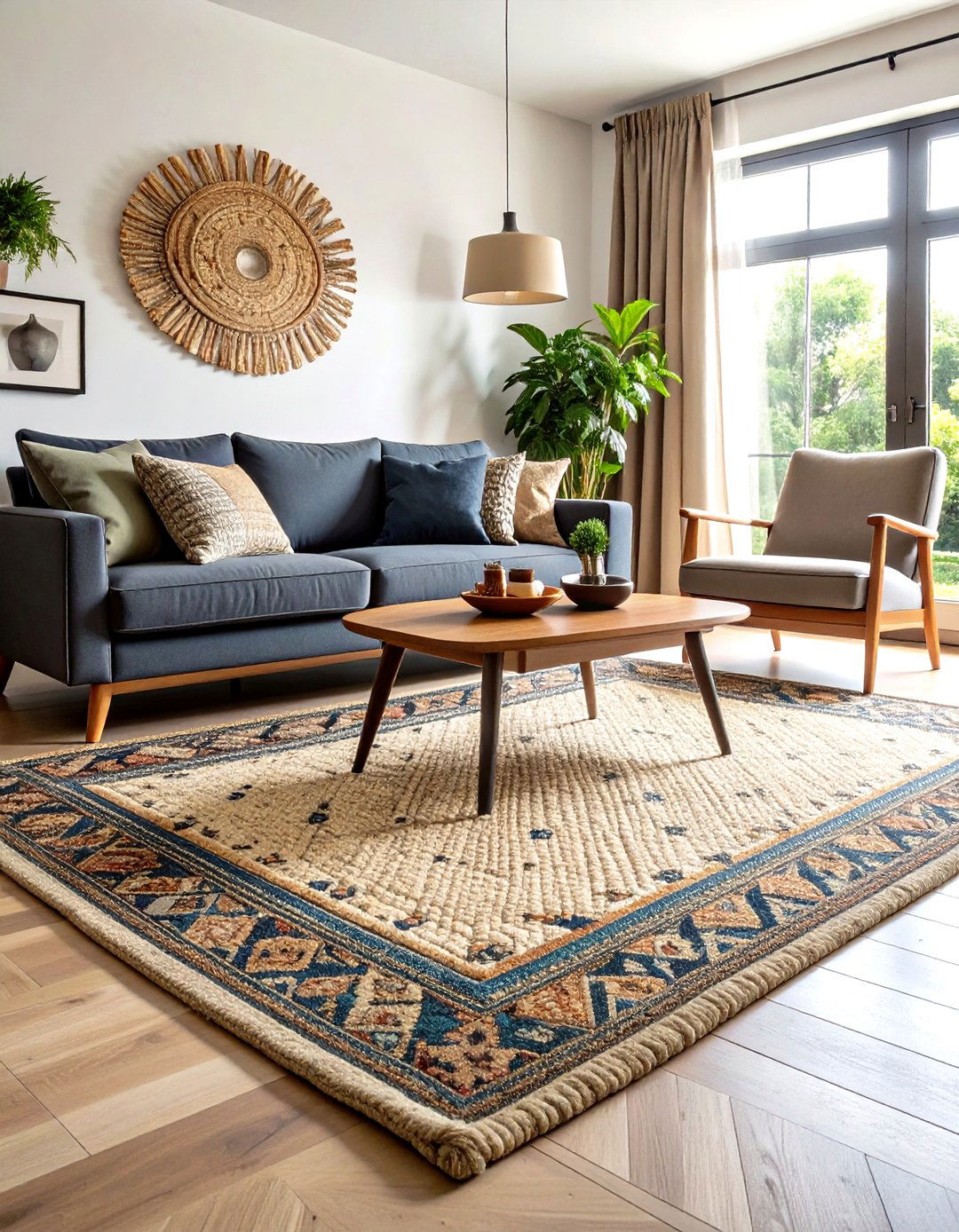
A pale woven rug—think oatmeal jute or cream wool—provides welcome contrast and keeps the room from feeling bottom-heavy. Flooring experts show how soft neutrals bounce scarce daylight upward, brightening furniture legs and lower walls. Pick a flat-weave style if you have pets: the lighter fibers highlight stray fur less than shag. Use a rug pad to raise the rug slightly, creating a subtle shadow line that adds yet more dimension. Repeating the rug’s hue in a throw pillow ties the palette together without overthinking.
8. Sheer Drapes Brighten Dark Living Rooms

Floor-to-ceiling sheers filter sunlight, diffusing it like a softbox across saturated walls. Home décor guides point out that semi-opaque panels preserve privacy while admitting up to 60 % of daylight—vital when paint absorbs brightness. Amazon Layer heavier blackout curtains behind sheers for nighttime insulation. To elongate the room visually, mount rods a few inches below the ceiling and let fabric kiss the floor. Pale linen or ivory polyester creates a luminous edge that frames windows as subtle light sources on gloomy days.
9. Greenery Breathes Life into Dark Living Rooms

Living plants supply instant vibrancy and purify air—an especially welcome boost in cocoon-like spaces. Shade-tolerant favorites such as ZZ plants, snake plants, and pothos survive low light while their glossy leaves pop against dark walls. Gardening Know How Cluster three varied heights—a tall fern, tabletop philodendron, and trailing ivy—to avoid a stiff lineup. Terracotta pots add earthy warmth; for a modern note, choose matte black planters that disappear visually and let foliage shine. Rotate pots monthly toward windows to keep growth balanced.
10. Moody Built-Ins Shape Living Room Zones
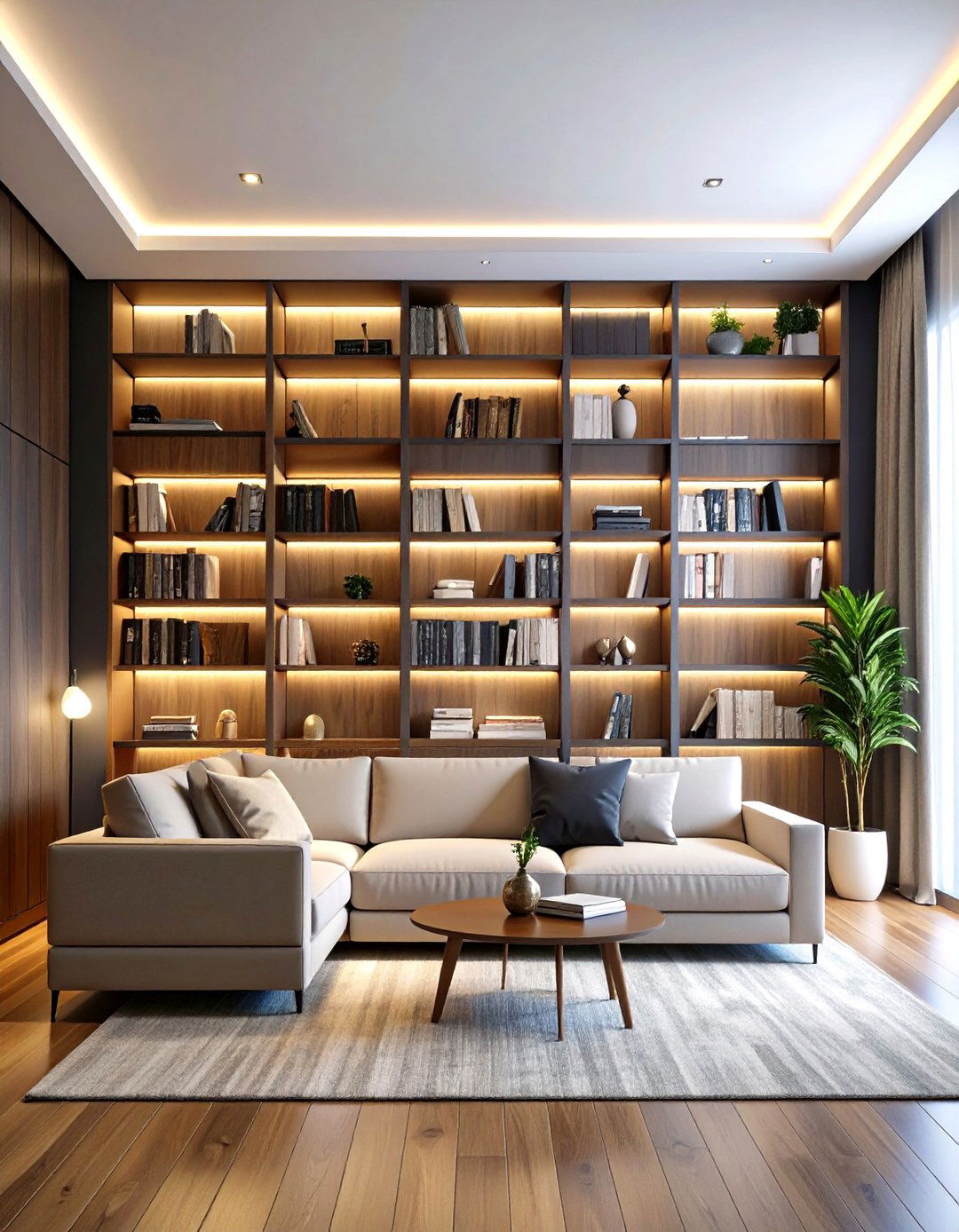
Painting built-in bookcases the same color as surrounding walls—known as color drenching—blurs boundaries and deepens atmosphere. Design pros say the unified palette anchors zones without bulky dividers, perfect for open-concept homes. Livingetc Add integrated LED strips along shelf undersides to highlight collectibles without glare. If your living room doubles as an office, tuck a laptop into a custom pocket inside the built-ins, allowing work to vanish at day’s end. Keep shelf styling simple—staggered stacks and a few sculptural objects—to prevent dark cubbies from feeling cluttered.
11. Subtle Mirrors Spark Living Room Light
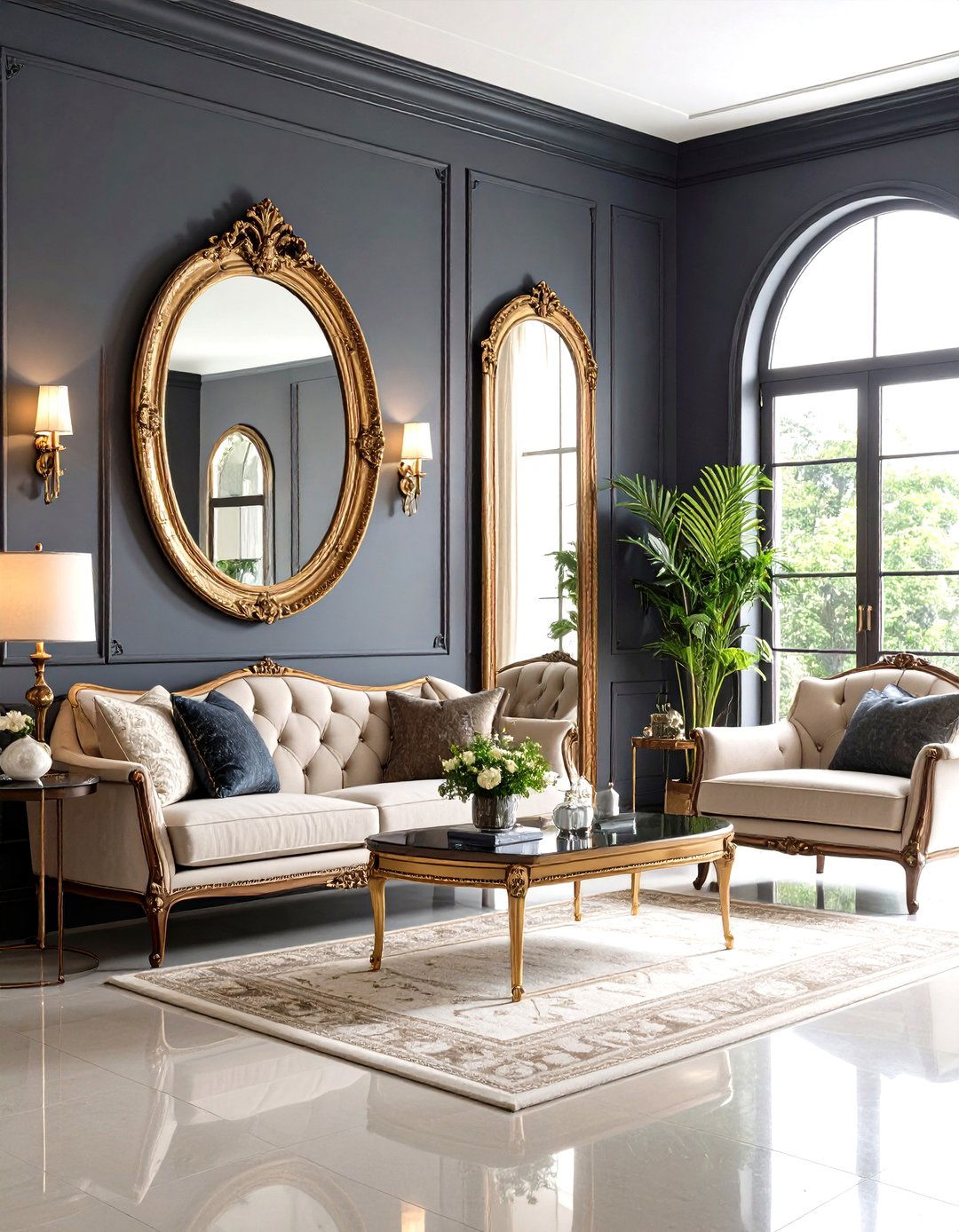
Strategically placed mirrors double available glow by bouncing lamp and window light around the room. Interior guides advise hanging one opposite your main light source for maximum effect, then tilting it slightly downward to avoid reflections of blank ceilings. Antique brass or matte-black frames keep within the moody palette. For a softer touch, group three small round mirrors at differing heights to mimic glimmering bubbles. Clean glass regularly; even a thin film of dust dulls reflected brightness.
12. Jewel-Tone Velvet Seats Energize Living Rooms
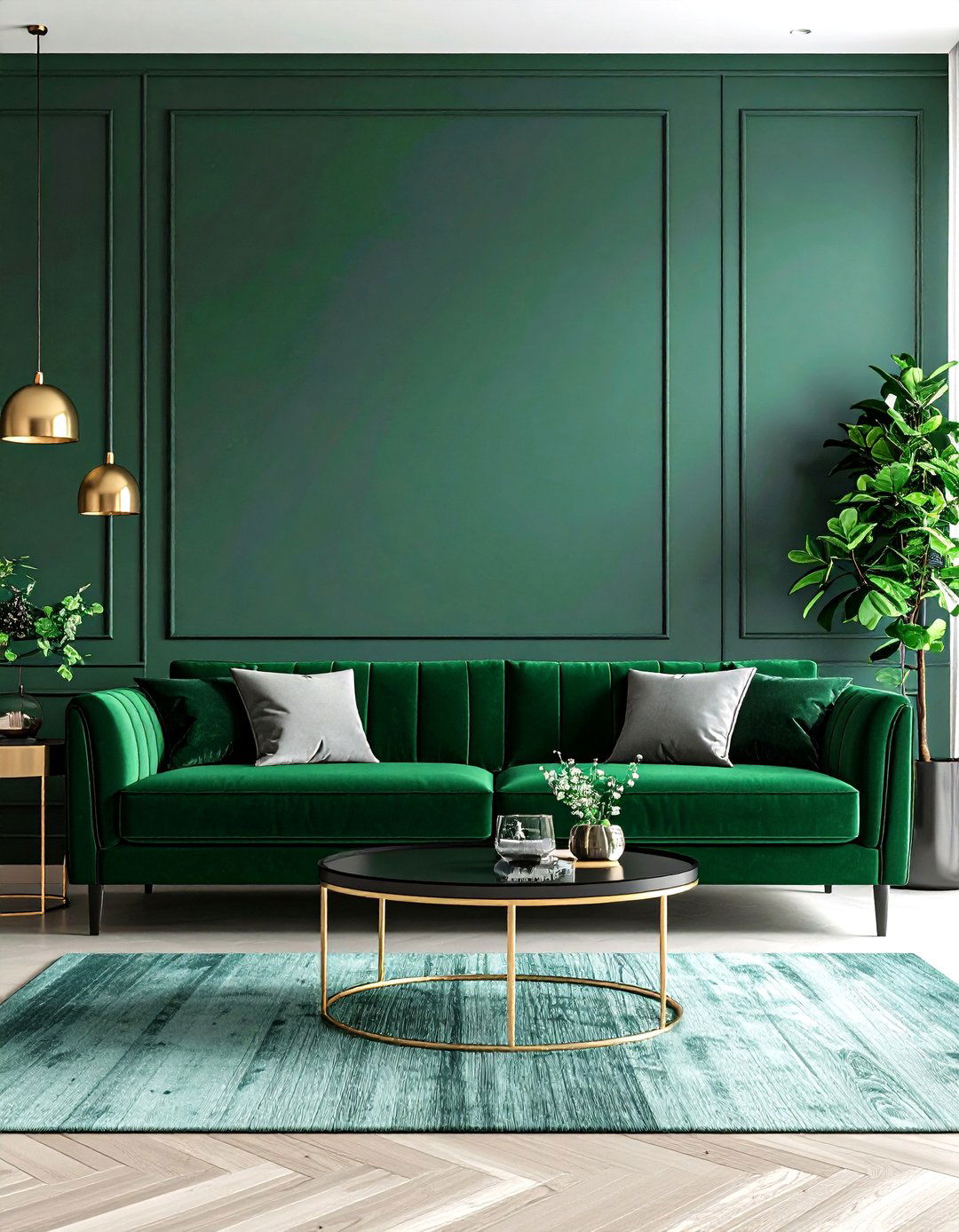
Emerald, sapphire, and garnet upholstery inject playful richness amid subdued walls. Trend reports show jewel hues reading almost neutral when surrounded by deeper charcoals, so you can layer multiple tones without chaos. Pinterest Choose performance velvet to resist crushing and stains; its slight sheen bounces ambient light. If a full sofa feels bold, start with an ottoman or slipper chair. Tie the color story together by echoing the upholstery in a throw or two art prints for harmony.
13. Candle Clusters Enhance Living Room Ambience
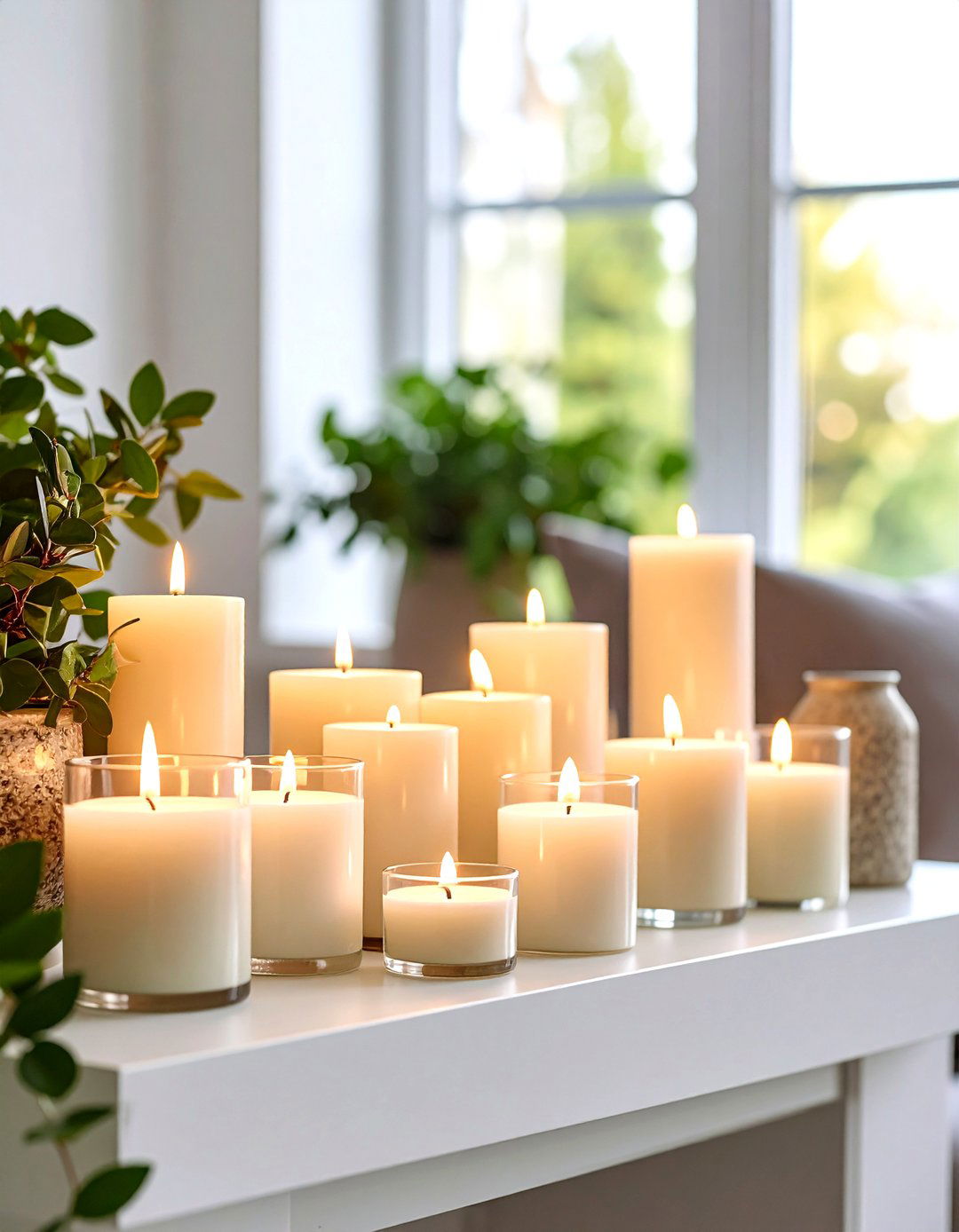
Nothing complements dark interiors like flickering candlelight. Hygge enthusiasts cite research that the gentle flame lowers heart rate and signals the brain to relax, making evenings feel restorative. Arrange pillar candles of varying heights on a heat-proof tray or fill vintage brass holders across the mantle. Unscented varieties prevent fragrance overload; reserve one subtle aroma—think cedarwood—for special nights. Always position candles away from hanging fabrics and use snuffers to minimize smoke marks on fresh paint.
14. Statement Ceilings Crown Dark Living Rooms
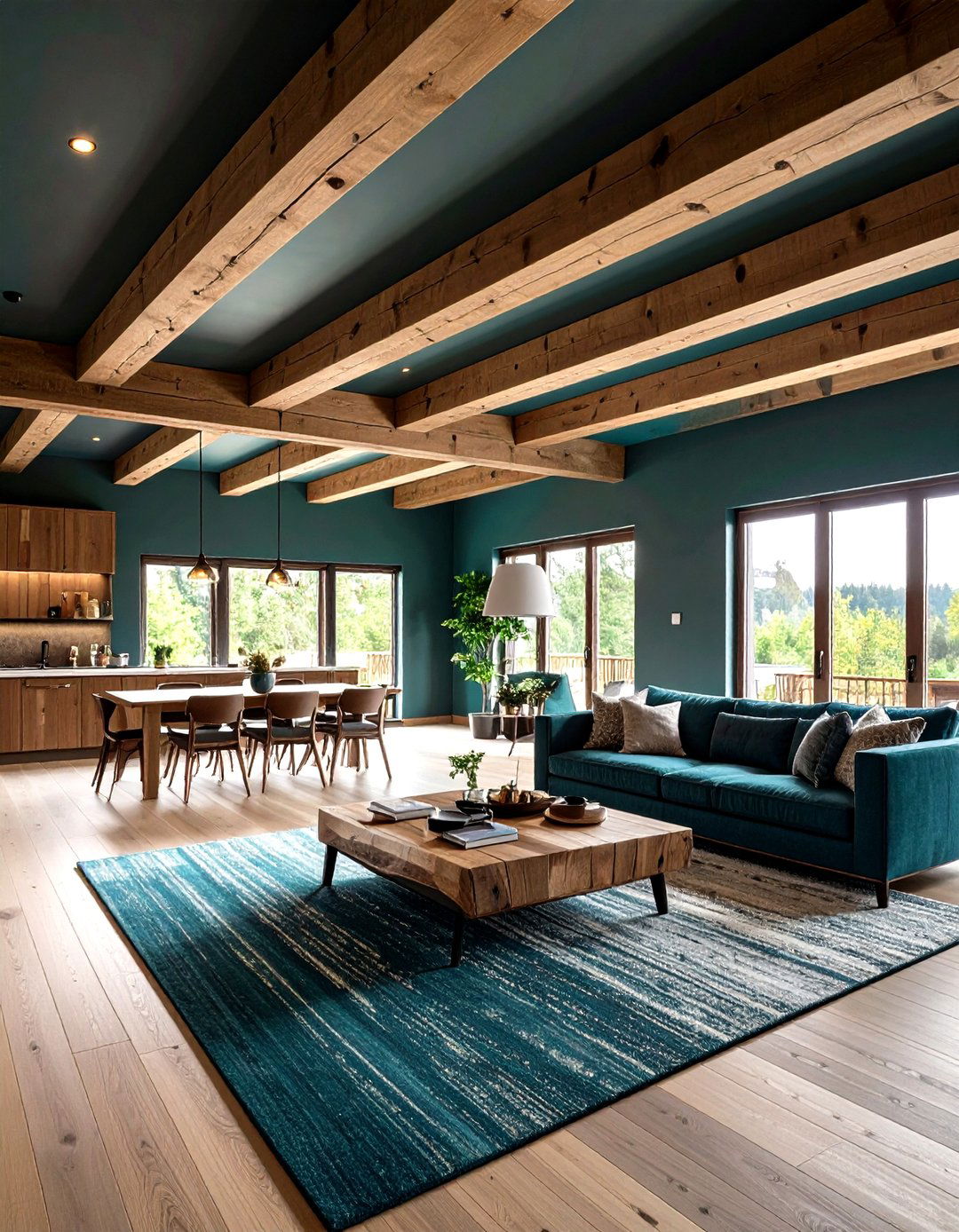
Painted beams, coffer details, or even a contrasting dark ceiling amplify drama and pull eyes upward. Idea boards showcase vaulted ceilings in charcoal with natural-wood beams for cabin-like charm, while flat ceilings in deep teal create jewel-box intimacy. Pinterest Keep crown molding the same color as the ceiling to avoid fussy breaks. When painting overhead, choose a washable matte finish—it hides roller marks better under angled light. Highlight the treatment with a discreet uplight strip along perimeter molding for evening glow.
15. Floor-to-Ceiling Shelves Enrich Living Rooms
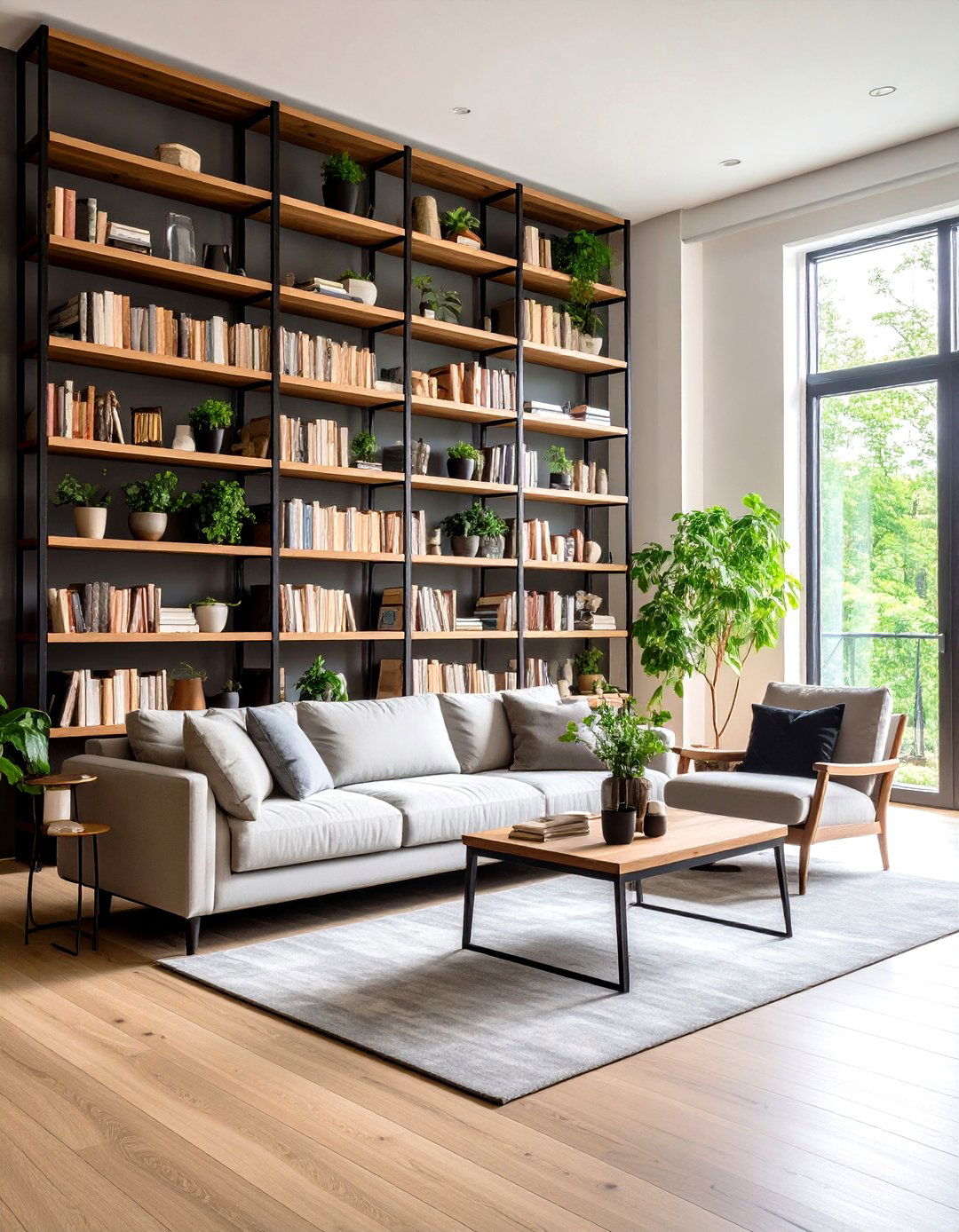
Towering bookshelves turn unused wall space into a textured backdrop that absorbs echoes and showcases personality. Reading-nook inspiration photos reveal how dark-painted shelves blend with walls, letting colorful book spines act as art. Pinterest Vary stacking—horizontal, vertical, and forward-faced—to create rhythm. Leave occasional negative spaces for ceramics or framed photos, avoiding a library-archive feel. For extra interest, line shelf backs with grass-cloth wallpaper in a tone-on-tone pattern; subtle sheen hints at depth when lamps are lit.
16. Smart Dimmers Tune Living Room Mood
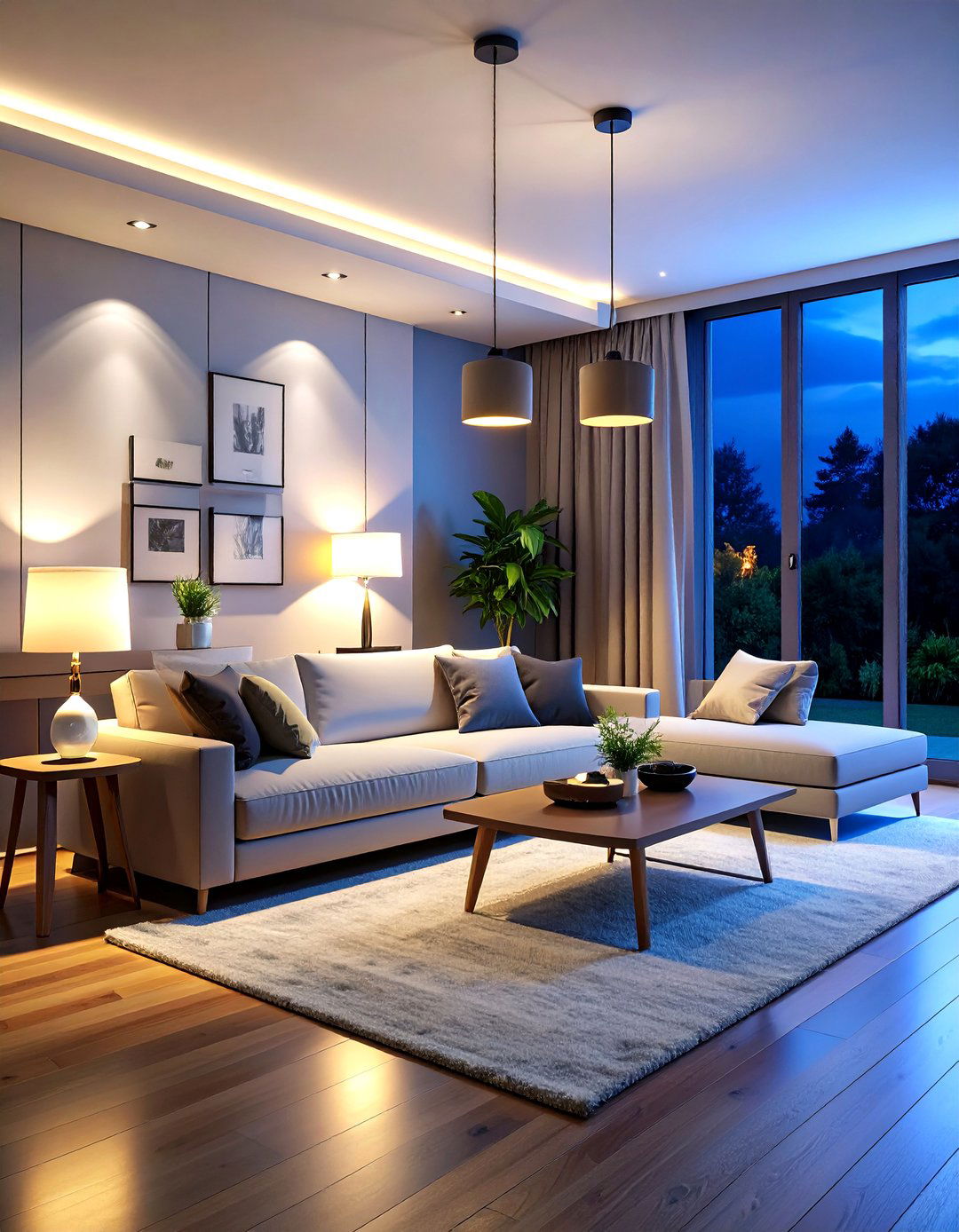
Smart dimmer switches let you slide from bright morning clarity to movie-night dusk with a fingertip or voice command. Lighting manufacturers highlight pre-set scenes—“relax,” “read,” “entertain”—that simplify daily transitions and save energy. Pair dimmers with warm LED bulbs to maintain color accuracy at low settings. If wiring upgrades are daunting, plug-in smart bulbs in key lamps achieve similar control through mobile apps. For renters, choose battery-powered remote dimmers that mount with adhesive strips and come off cleanly.
17. Mix Finishes for Living Room Depth
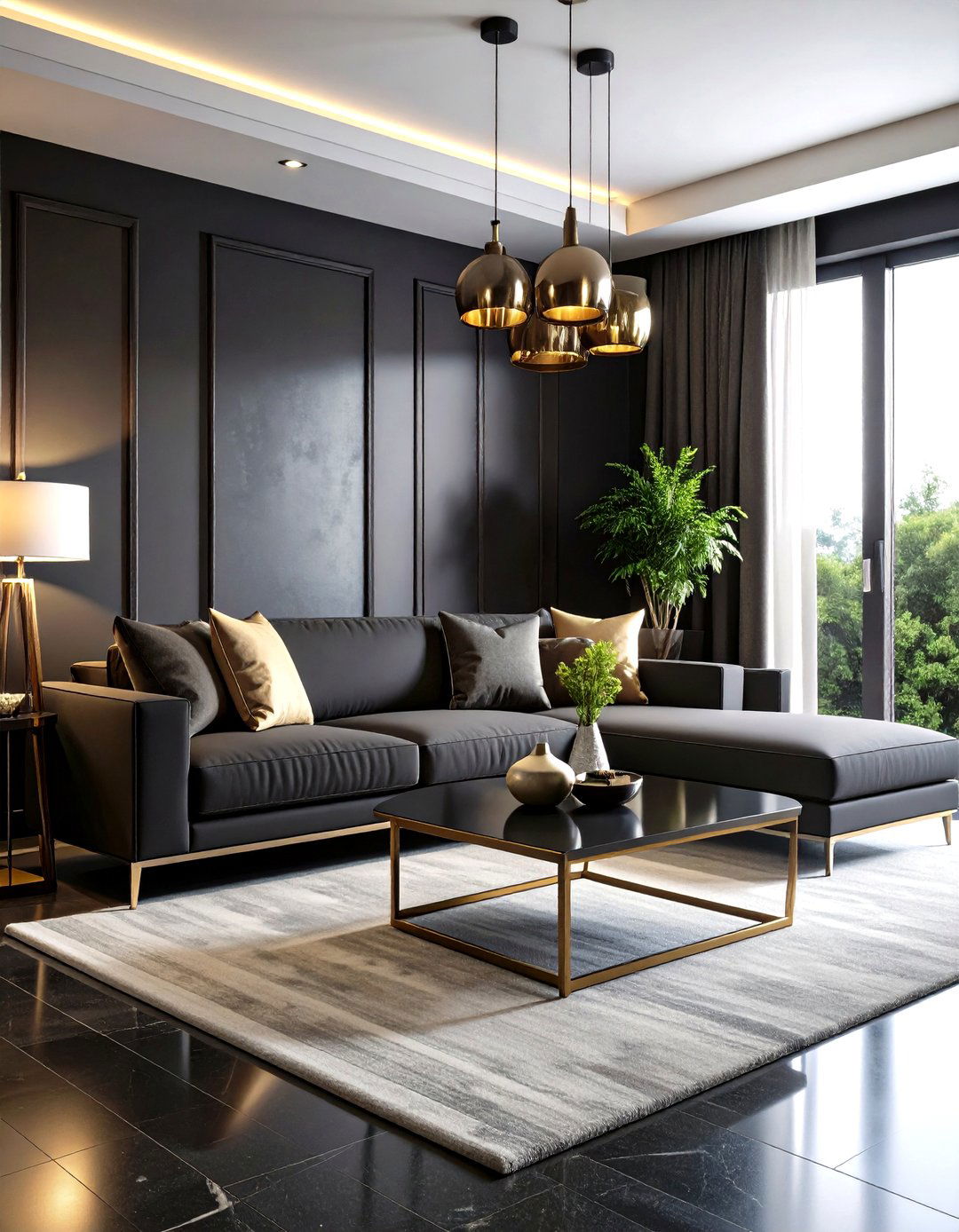
Combining matte walls with glossy accents introduces light play that keeps dark palettes lively. Design blogs explain that the sheen contrast adds subtle movement, making surfaces feel layered rather than flat. Try a high-gloss coffee table against eggshell walls, or matte pottery on a lacquer tray. Limit yourself to two or three finishes—too many compete and create visual noise. Wipe glossy pieces regularly; fingerprints stand out more against shine.
18. Minimal Clutter Calms Dark Living Rooms
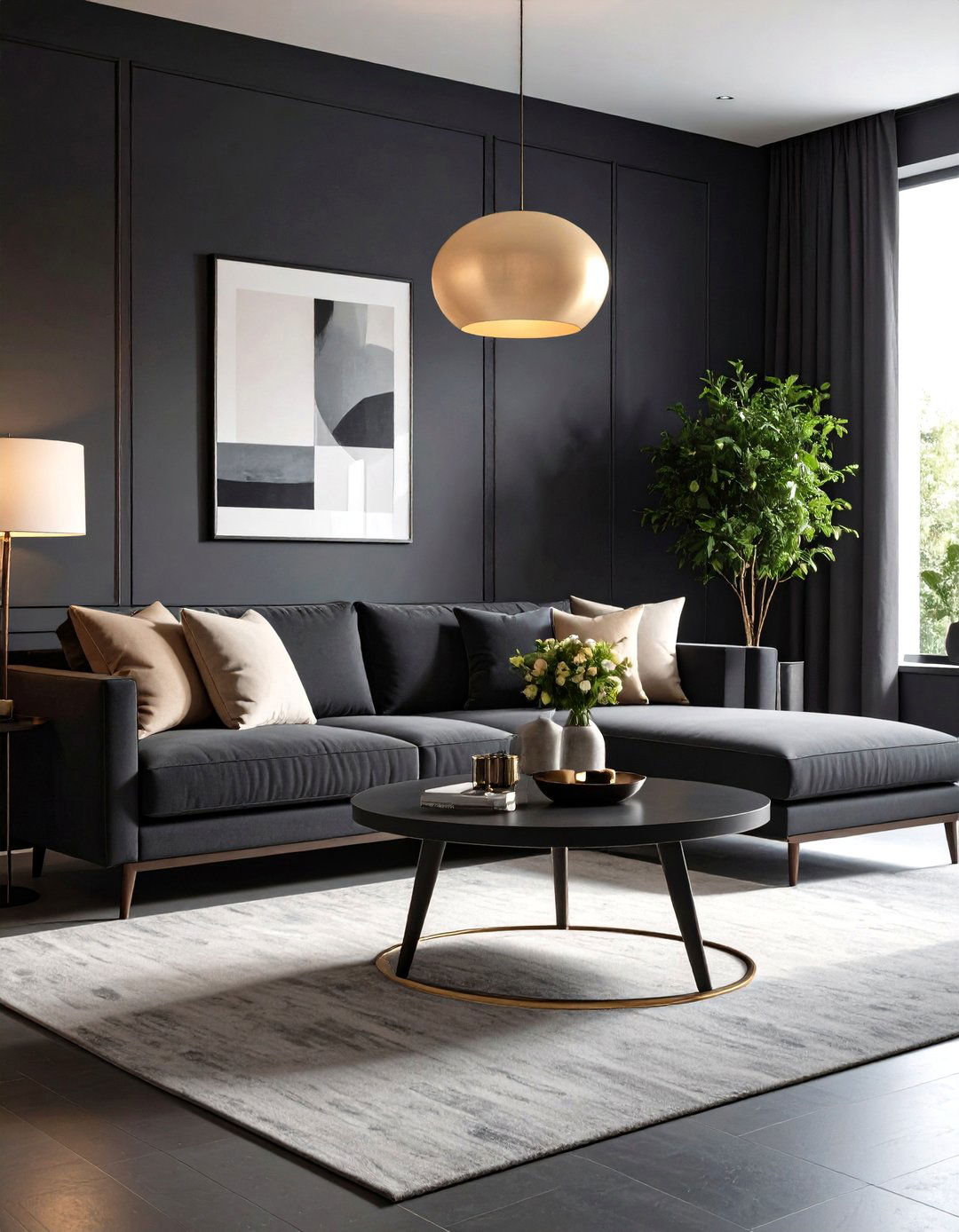
Because dark surfaces highlight shapes, excess décor can read as chaos. Decluttering guides recommend starting with the coffee table: remove non-essentials and leave one statement item like a sculptural bowl. Woman & Home Store remotes in a lidded box the same color as the sofa so they disappear visually. Keep wall art curated and leave breathing room between pieces. When purchasing new items, apply the “one in, one out” rule to maintain balance and let shadows remain serene rather than oppressive.
19. Highlight Living Room Architecture
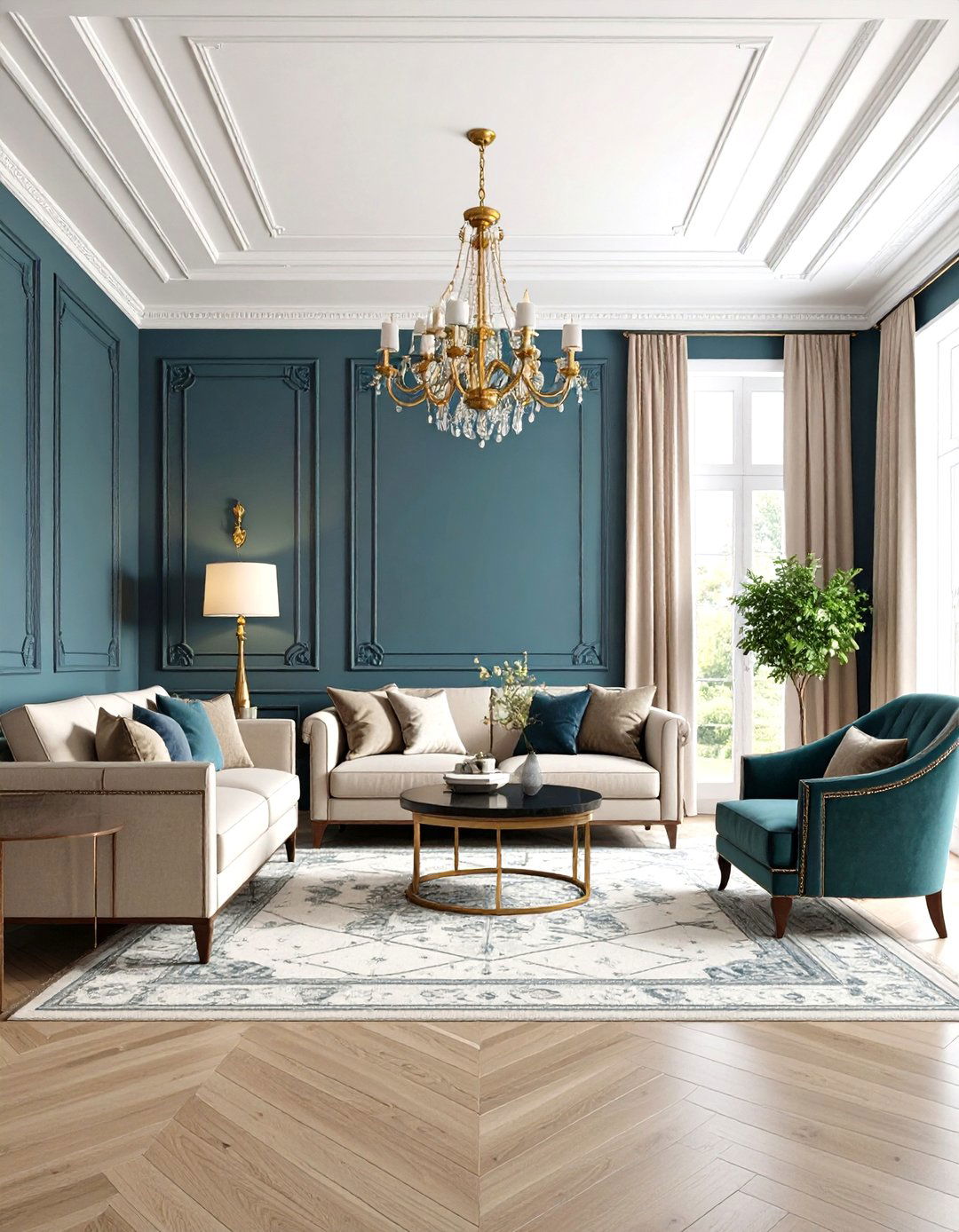
Painting trim, doors, and even ceiling coffers in the same deep hue as walls unifies quirky angles and spotlights craftsmanship. Color-drench advocates note that matching finishes hides uneven lines while making moldings feel like sculptural relief. Havenly If you prefer contrast, flip the script: keep trim crisp white against dark walls to frame views like picture mats. Either route, use a semi-gloss on woodwork for durability; its gentle sheen distinguishes details without glaring.
20. Global Textiles Personalize Dark Living Rooms

Hand-embroidered suzani pillows, kilim rugs, or indigo mud-cloth throws layer history and color atop moody foundations. Designers who favor timeless boho schemes stress mixing no-two-alike textiles for depth that reads curated, not cluttered. The Spruce Anchor the room with one hero piece—perhaps a richly patterned rug—then echo a single hue from that textile in two smaller accents elsewhere. Rotate fabrics seasonally: lighter cottons in summer, heavier wool blends in winter, ensuring the living room’s dark canvas evolves year-round.
Conclusion:
Leaning into darkness doesn’t shrink a living room—it magnifies texture, gleam, and comfort. By pairing deep paint with layered lighting, warm metals, tactile fabrics, and personal touches like global textiles or curated artwork, you craft a space that feels intimate yet vibrant. Smart dimmers, reflective mirrors, and pale rugs keep gloom at bay, while careful decluttering and unified built-ins maintain calm. With these strategies, every shadow becomes a design ally, proving that a dark living room can be the brightest idea in the home. Lushome


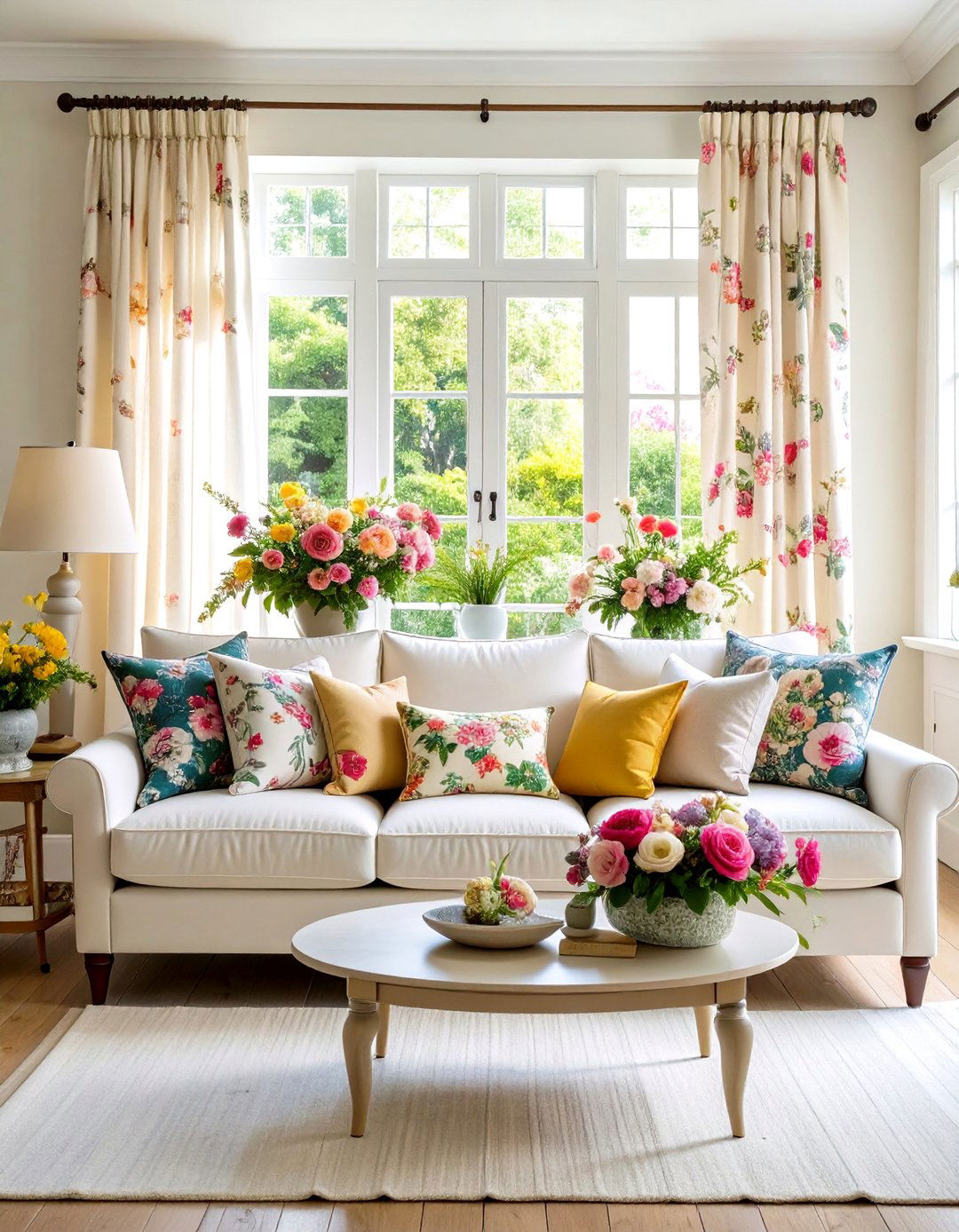
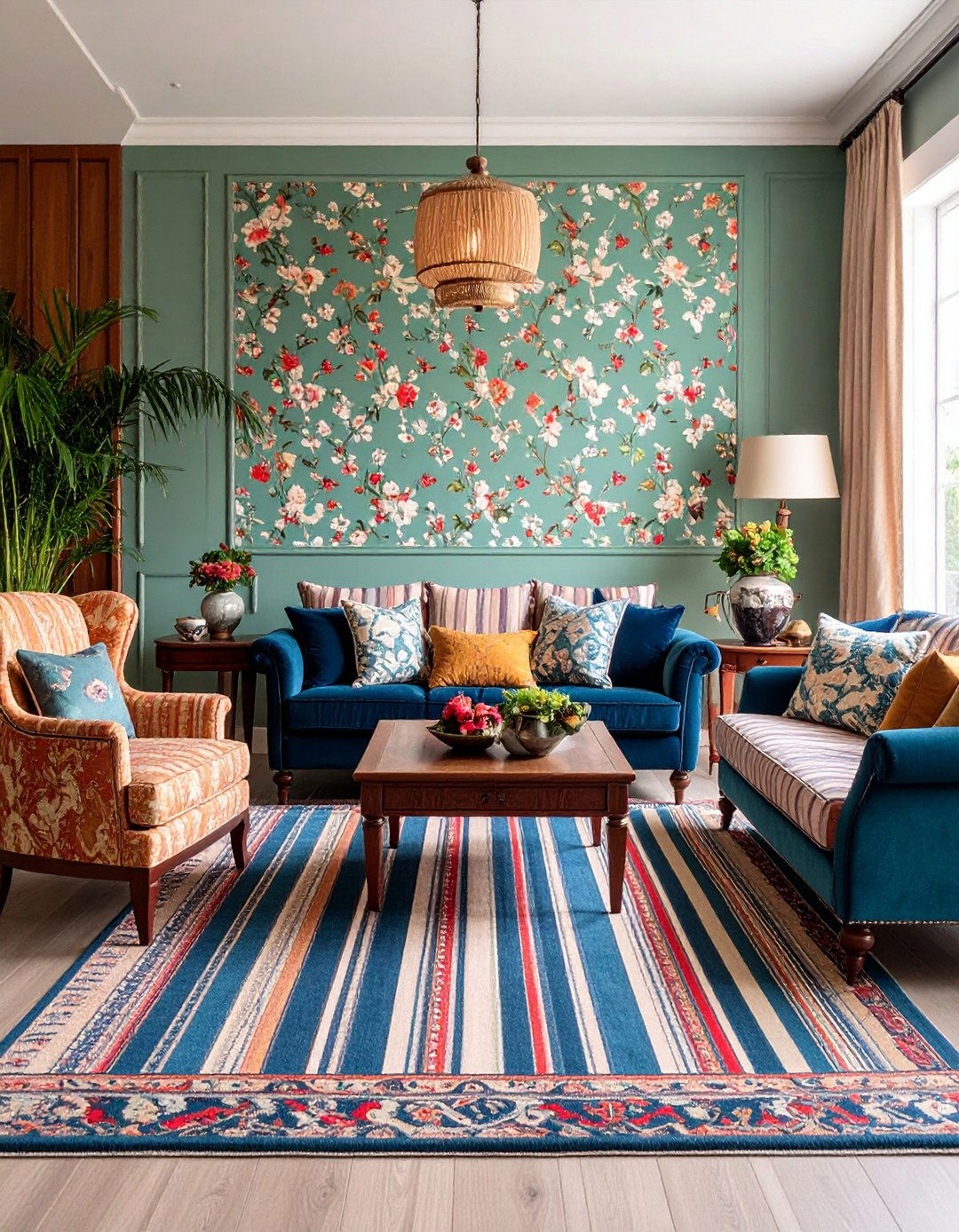
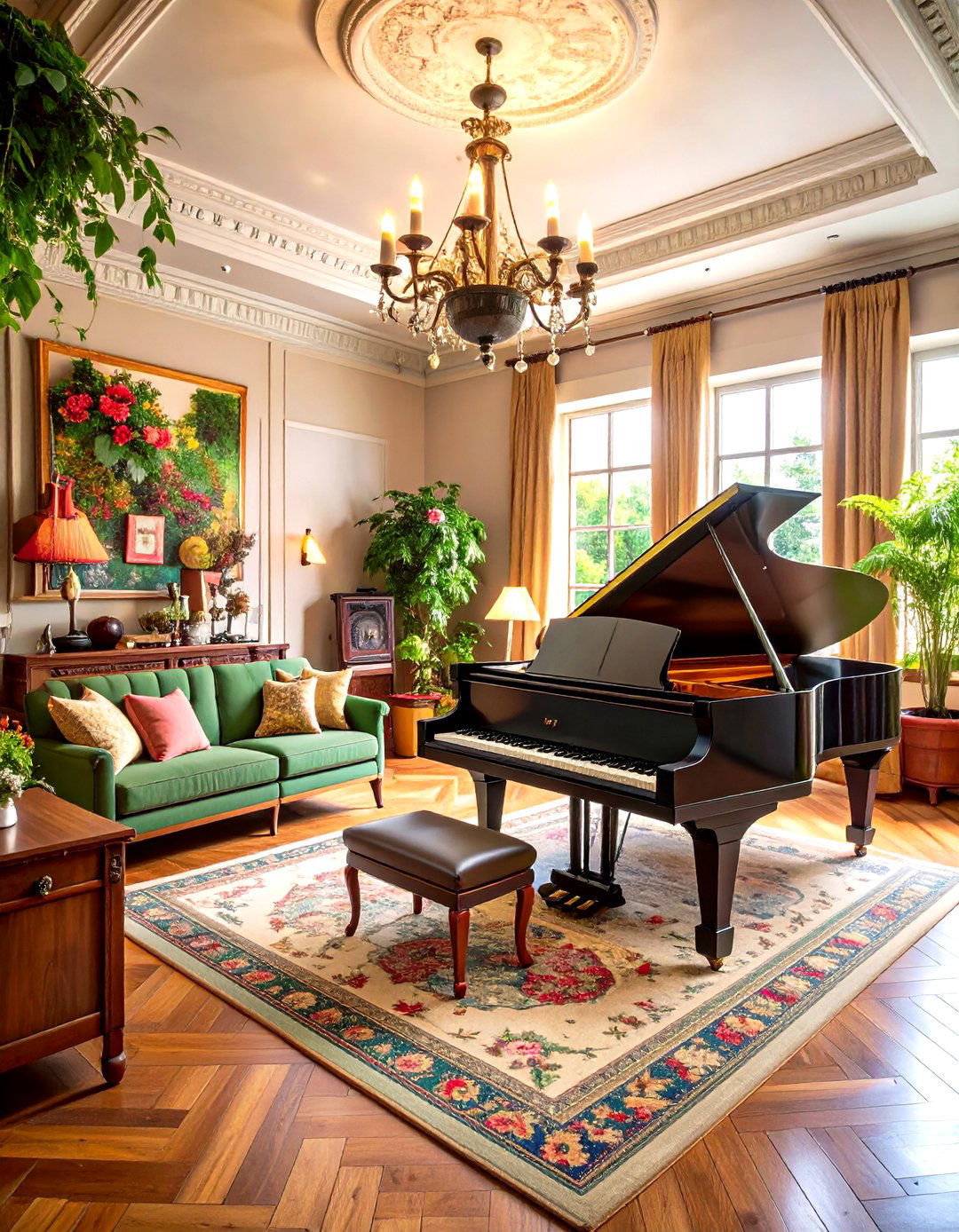

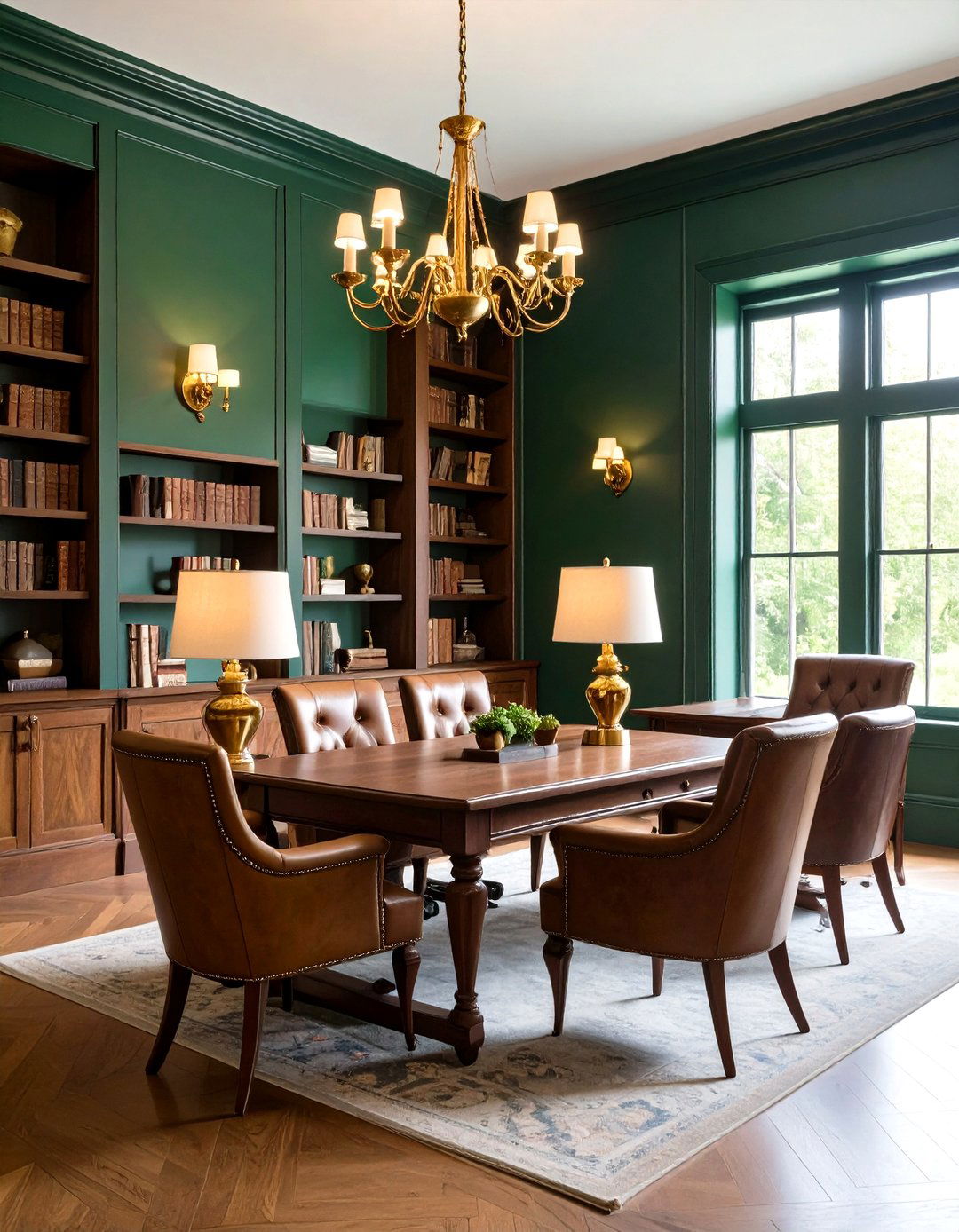
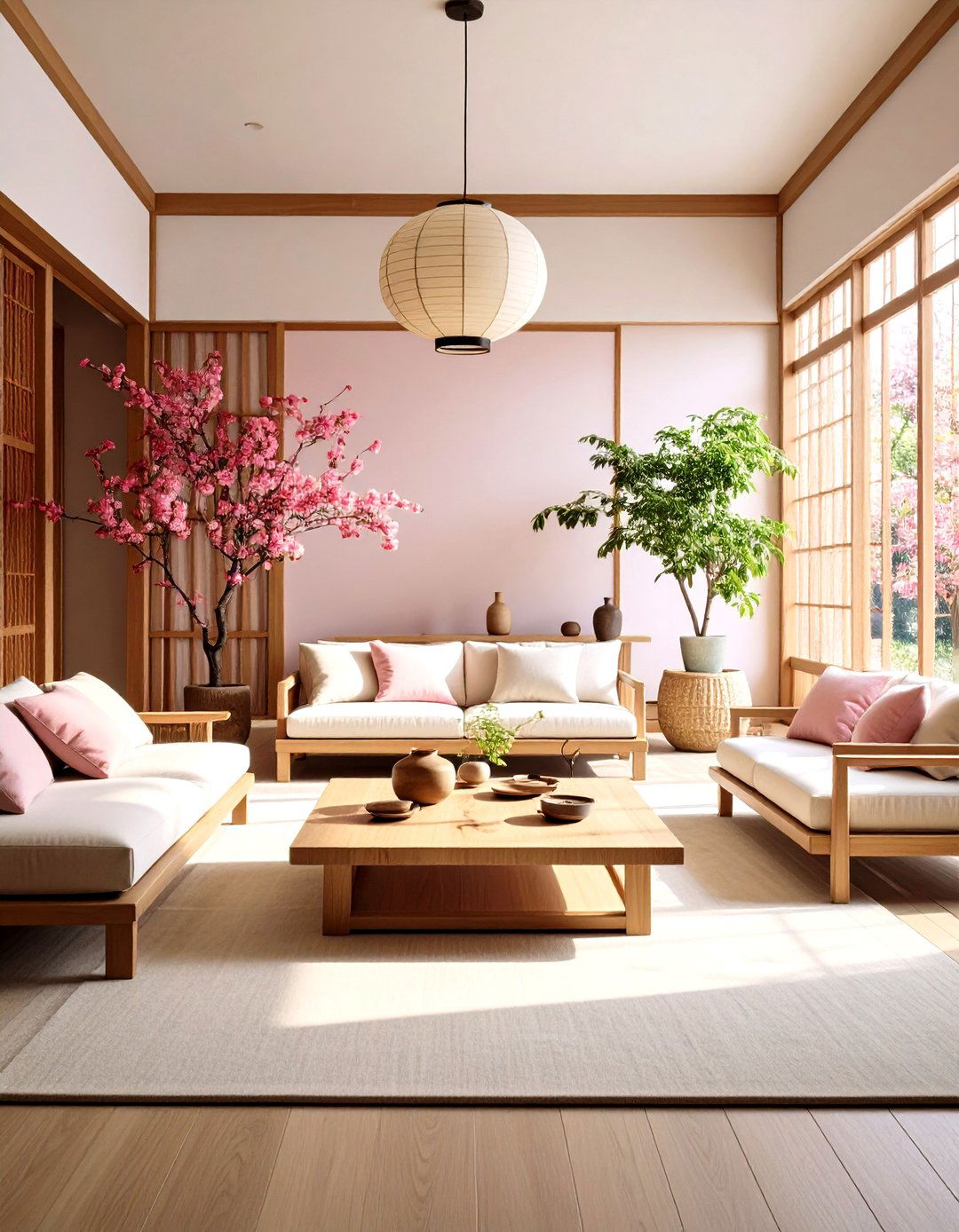
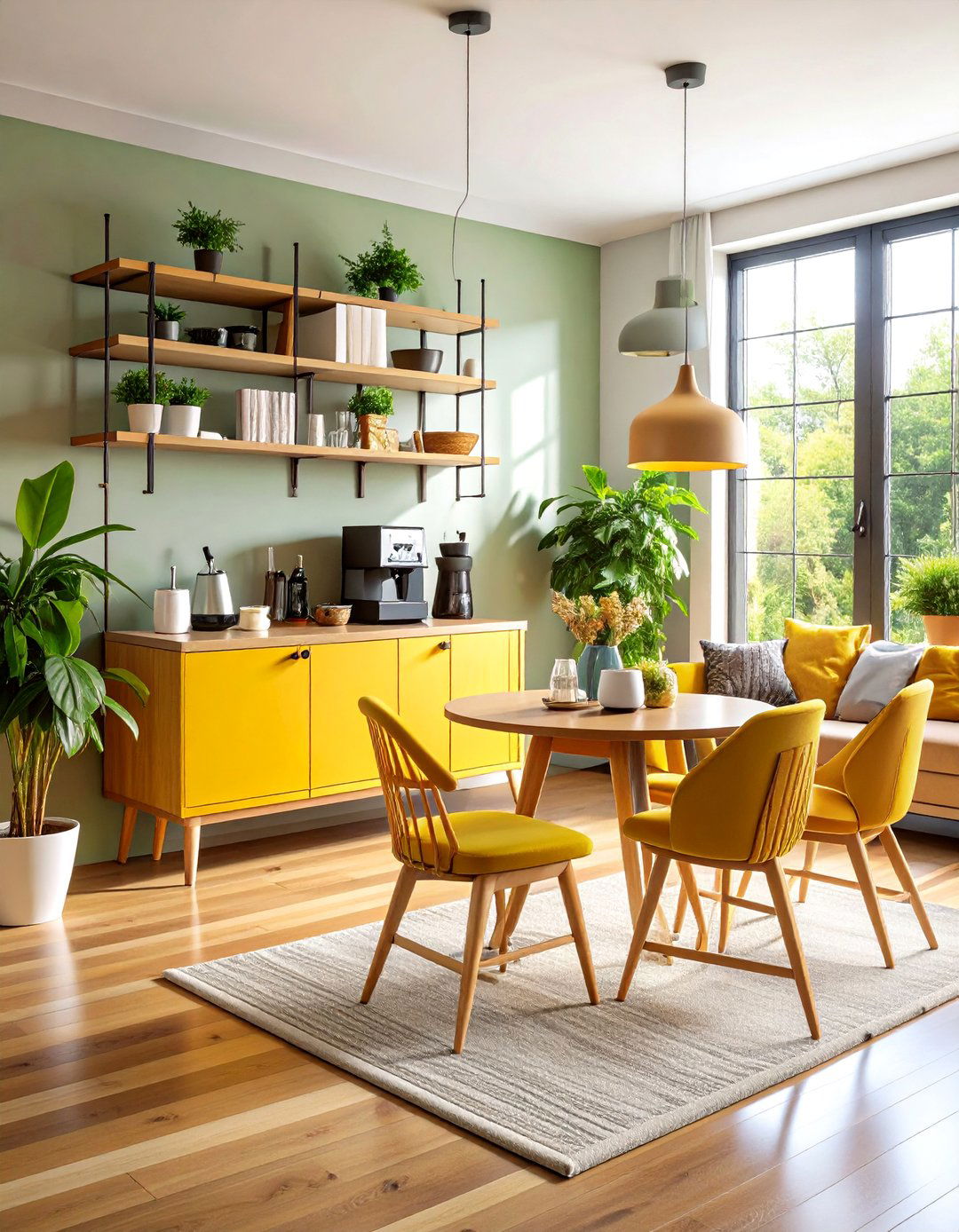
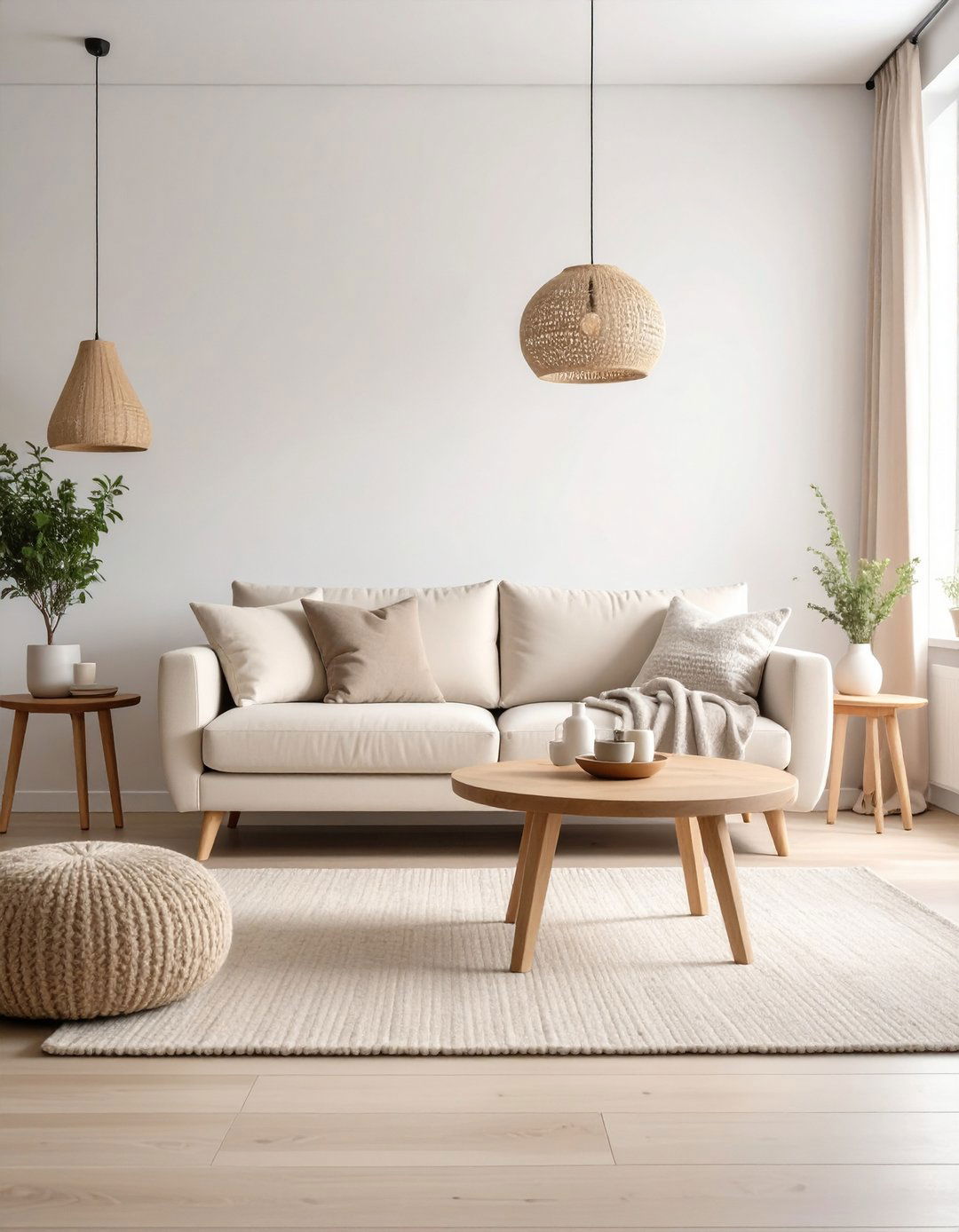
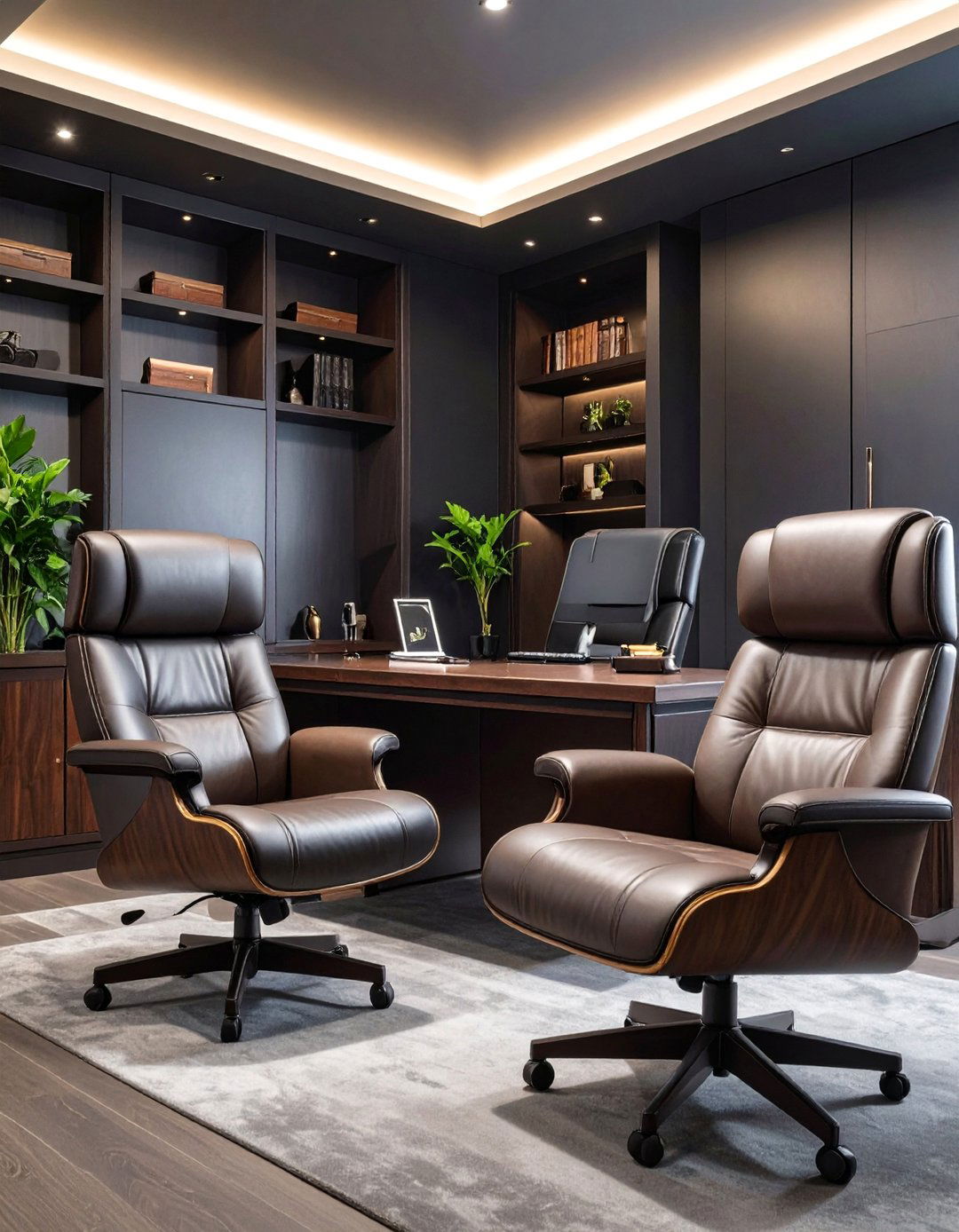

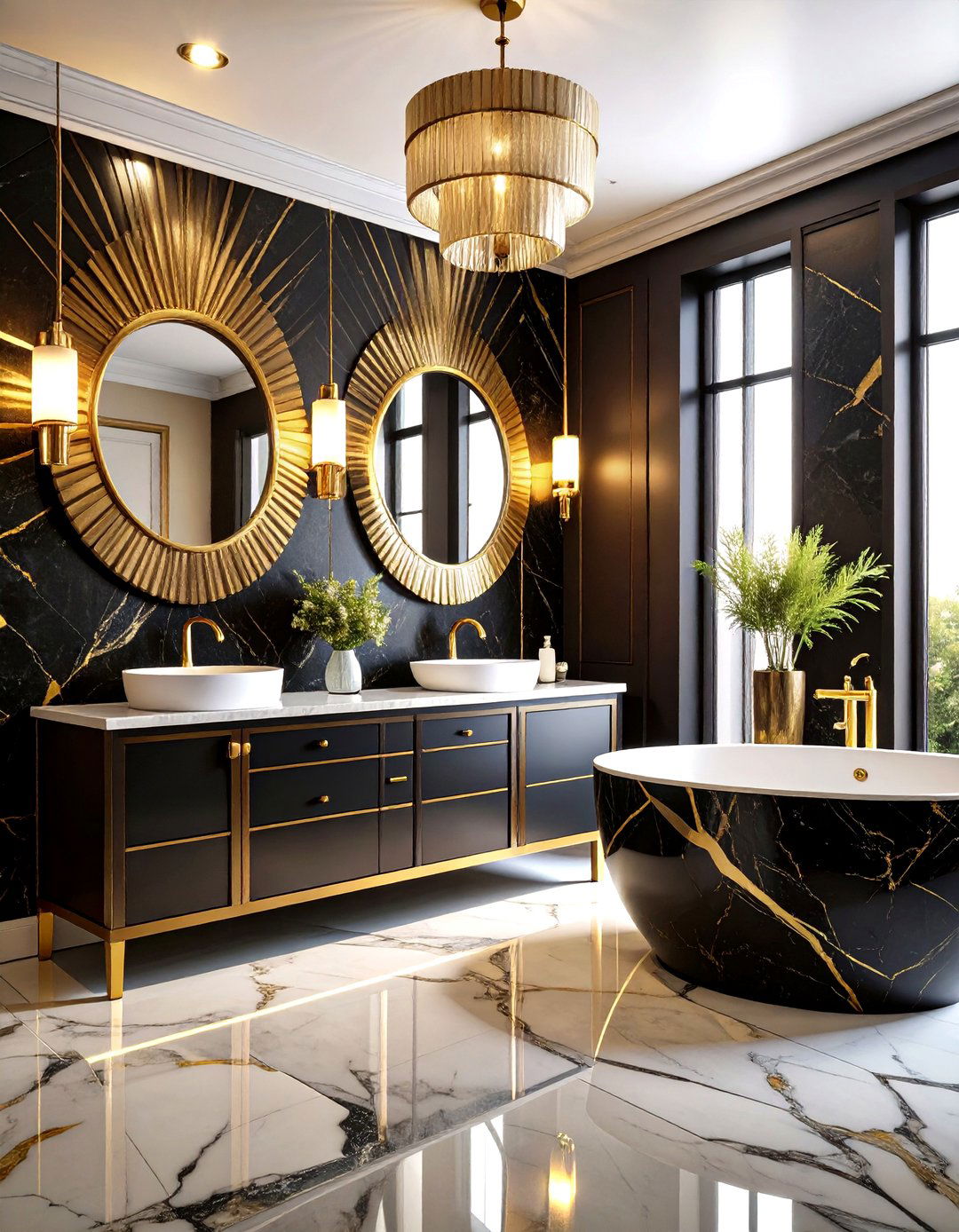
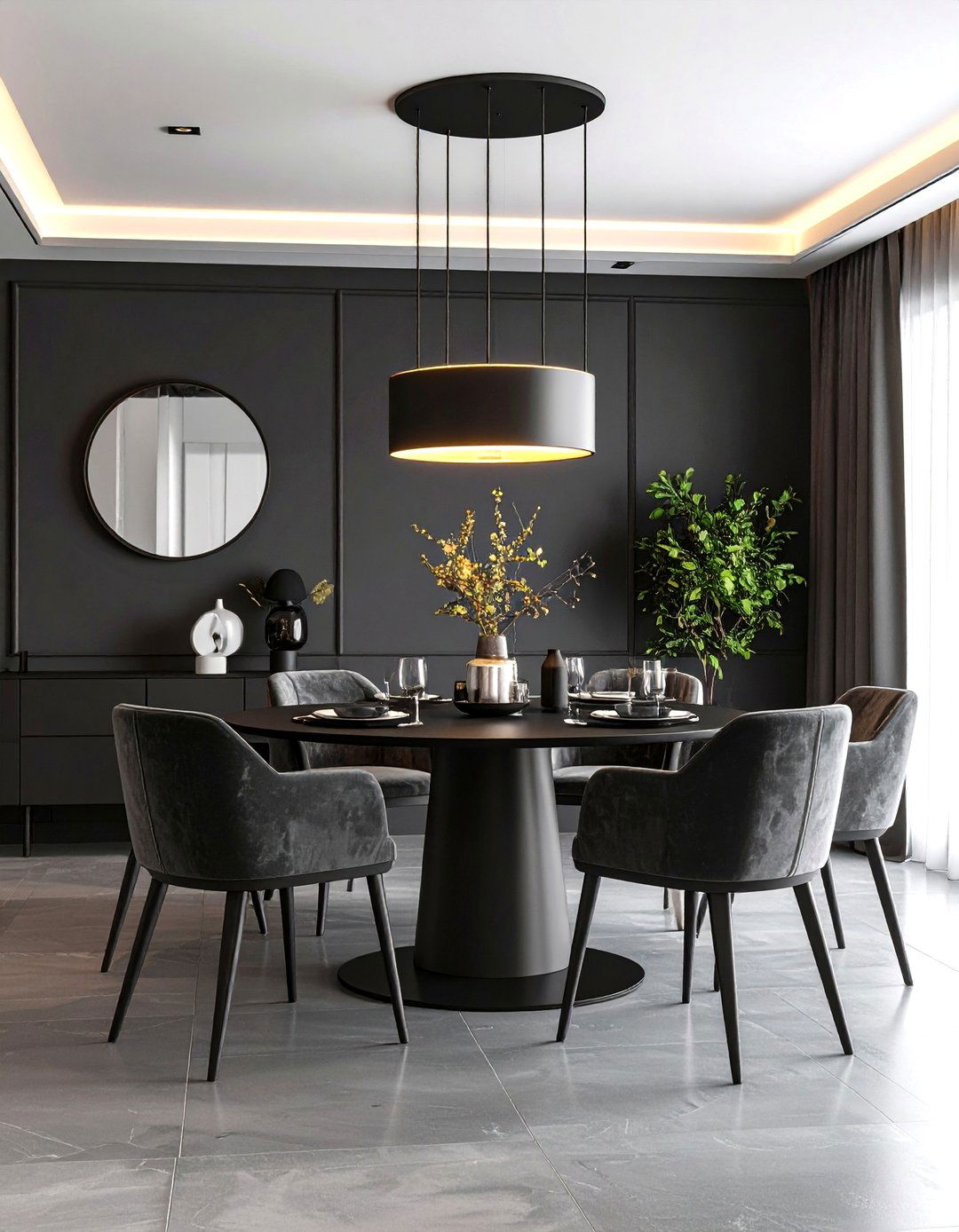
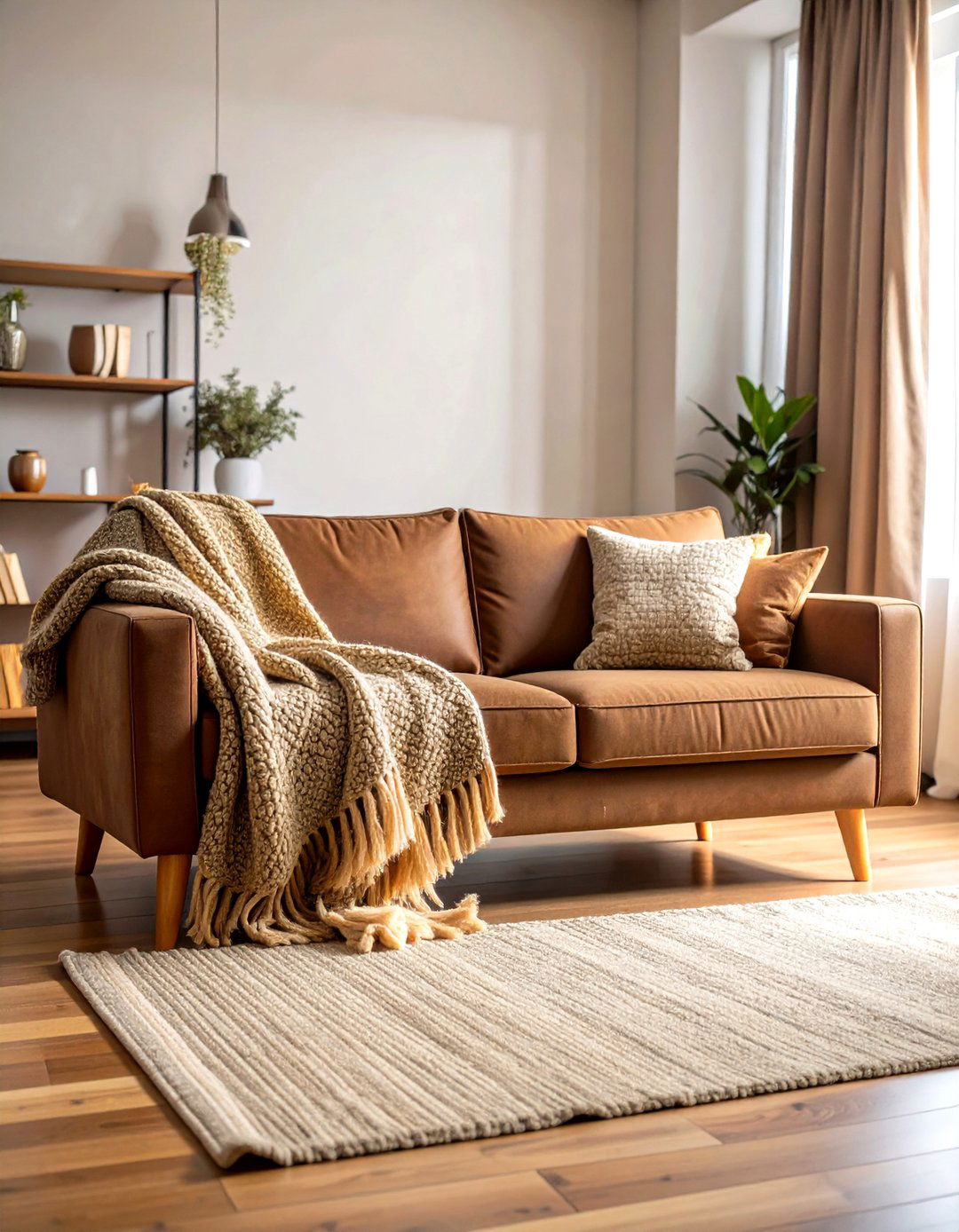
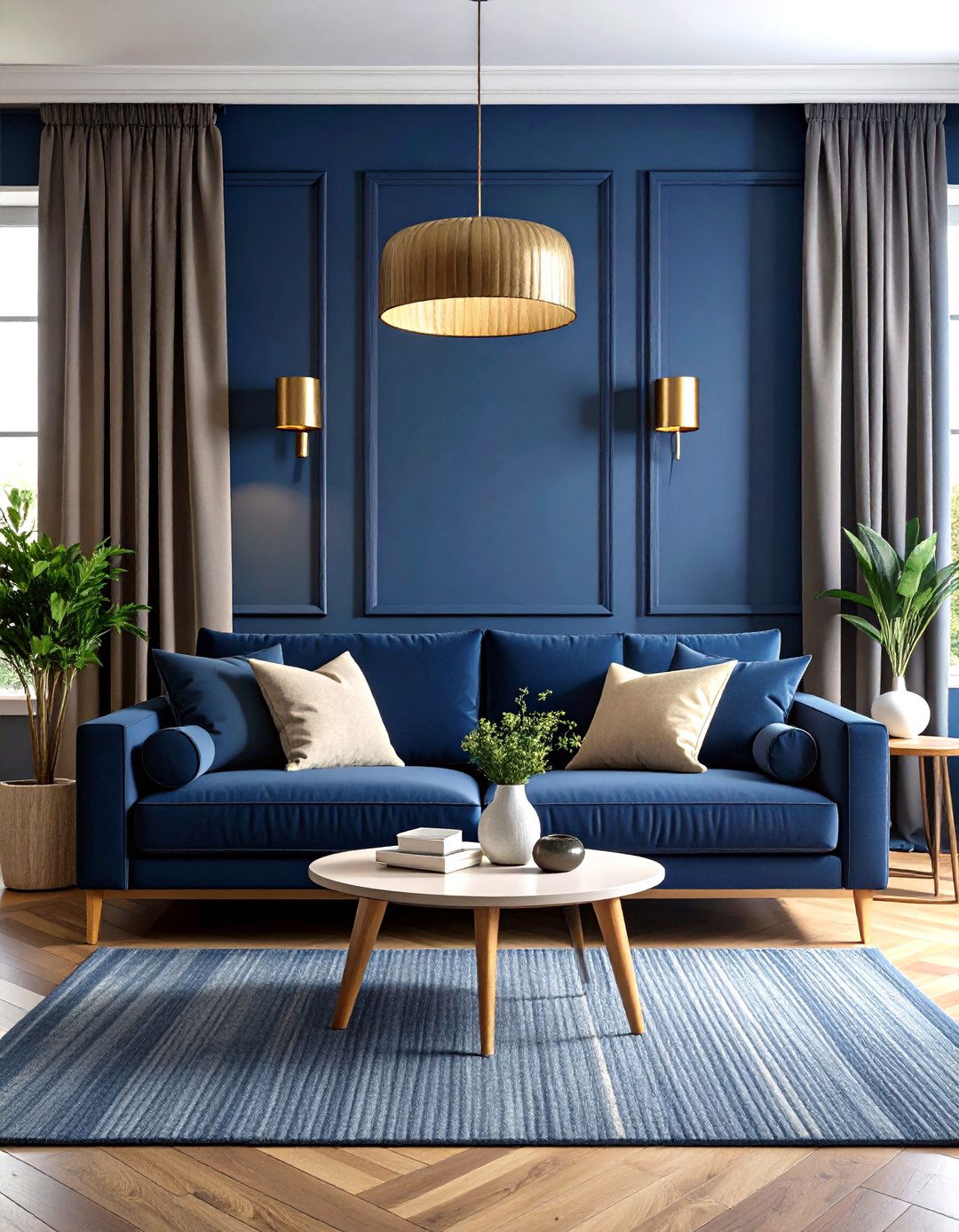
Leave a Reply